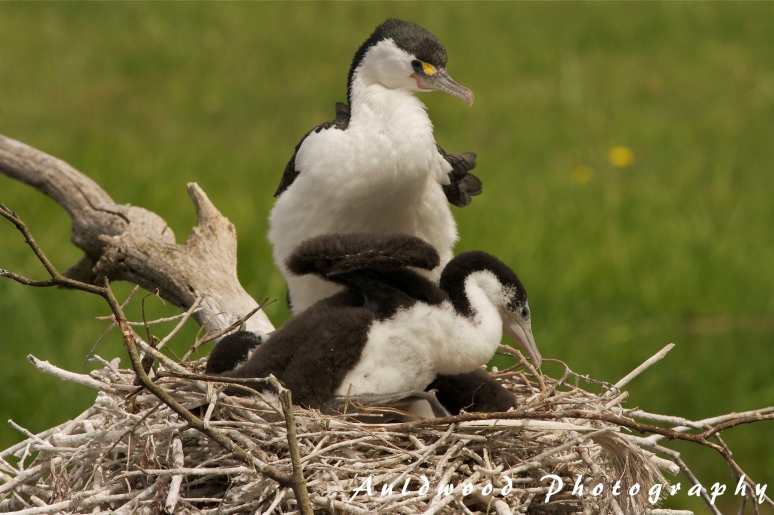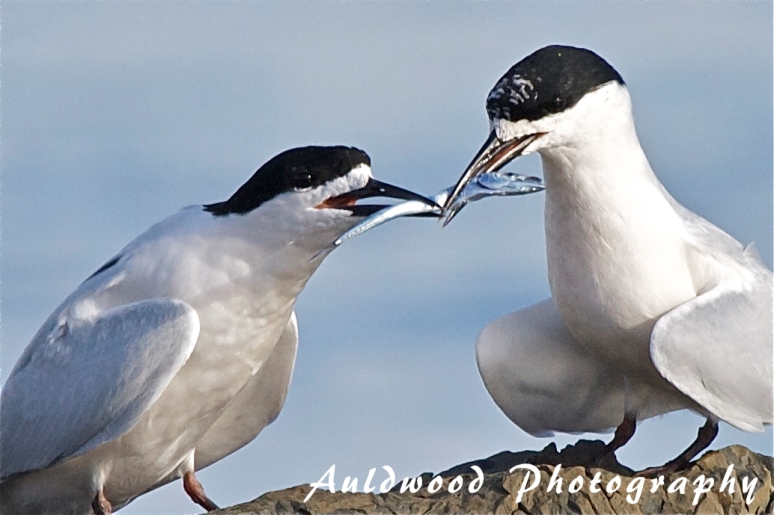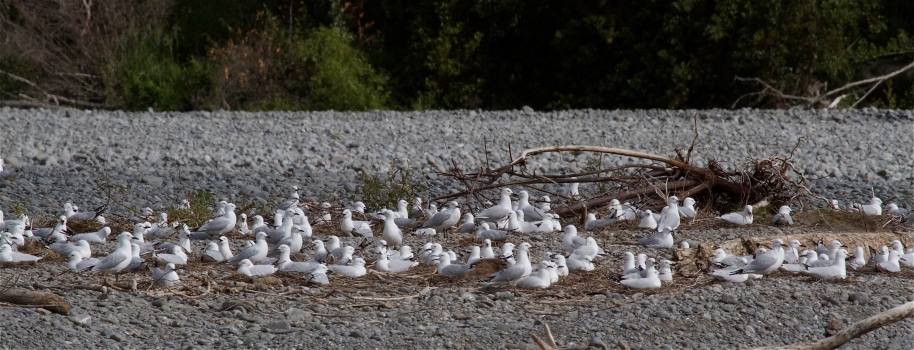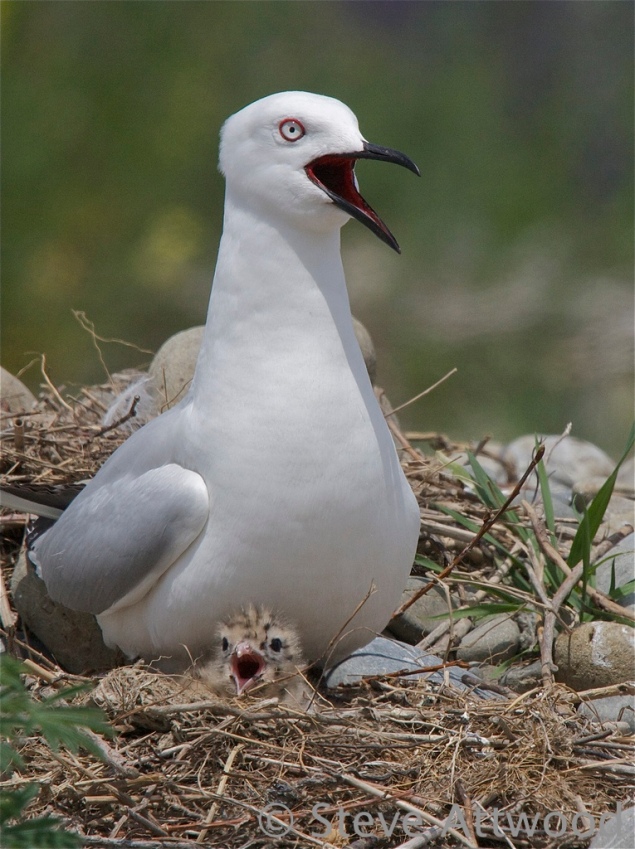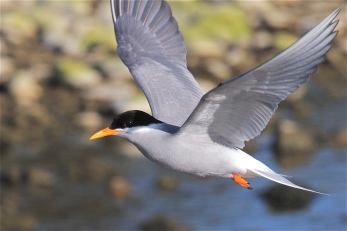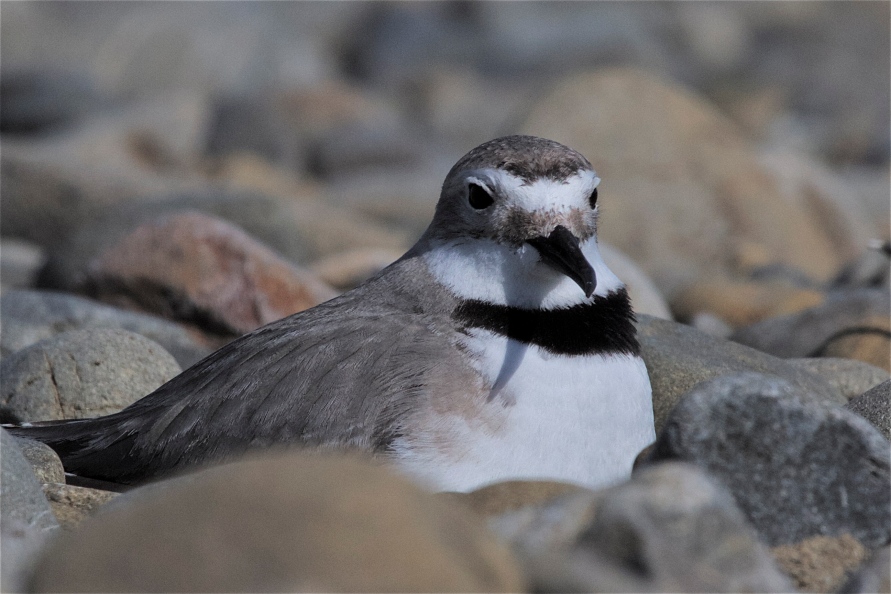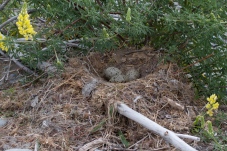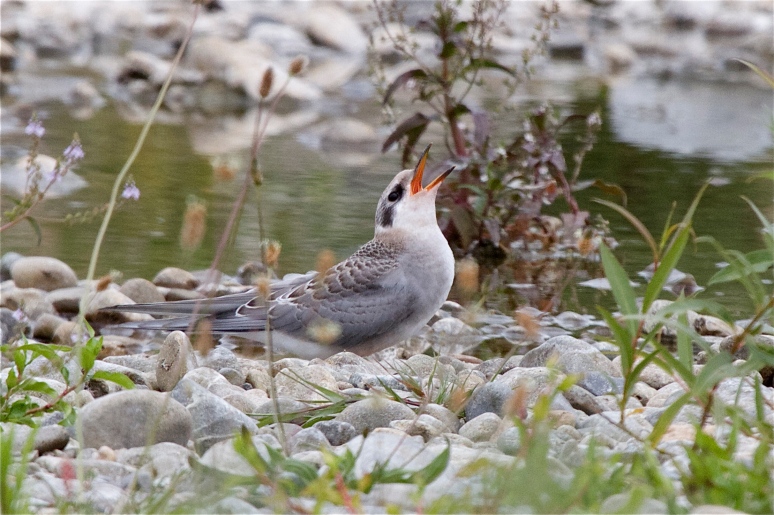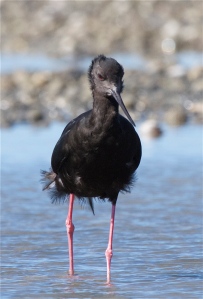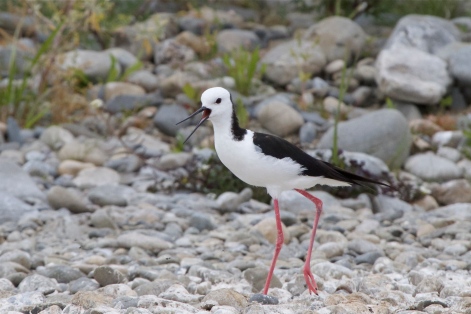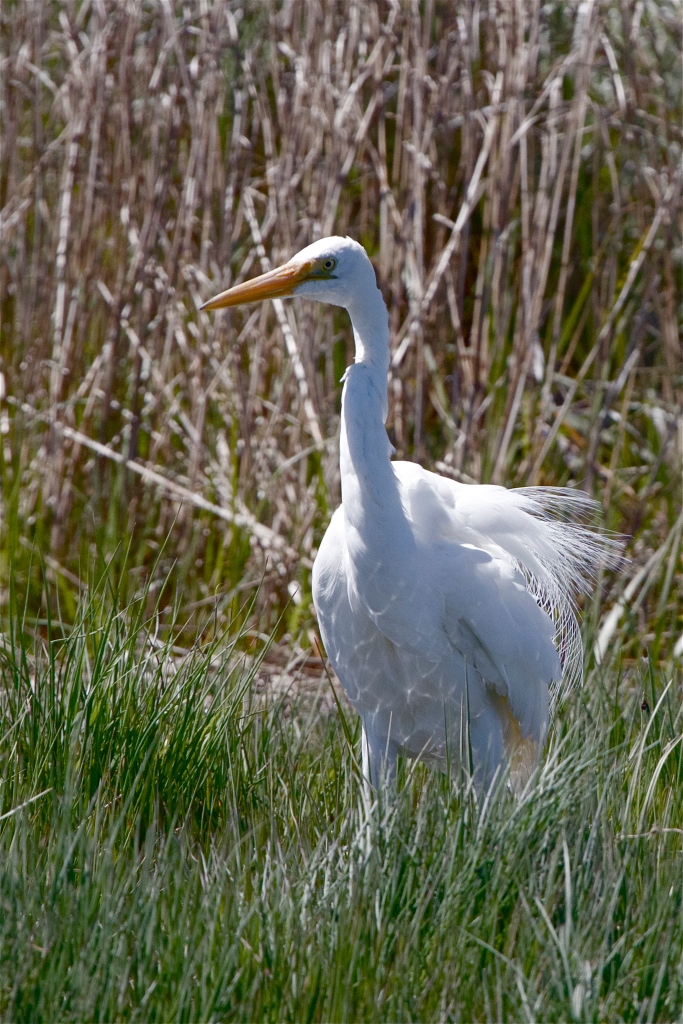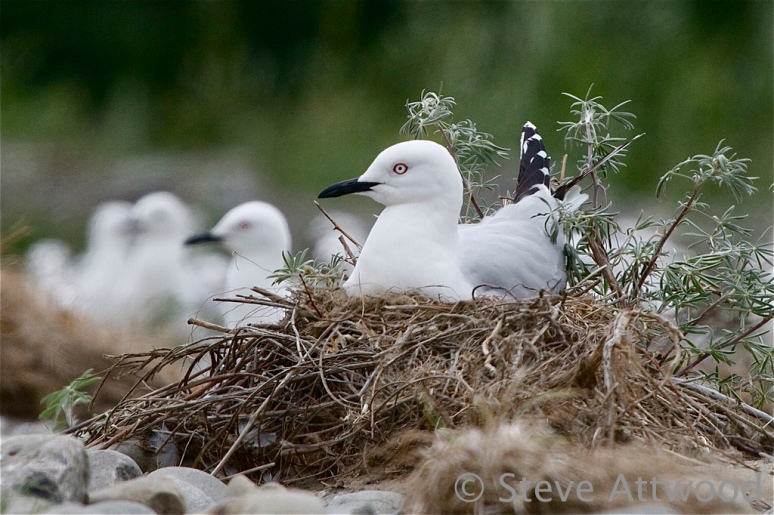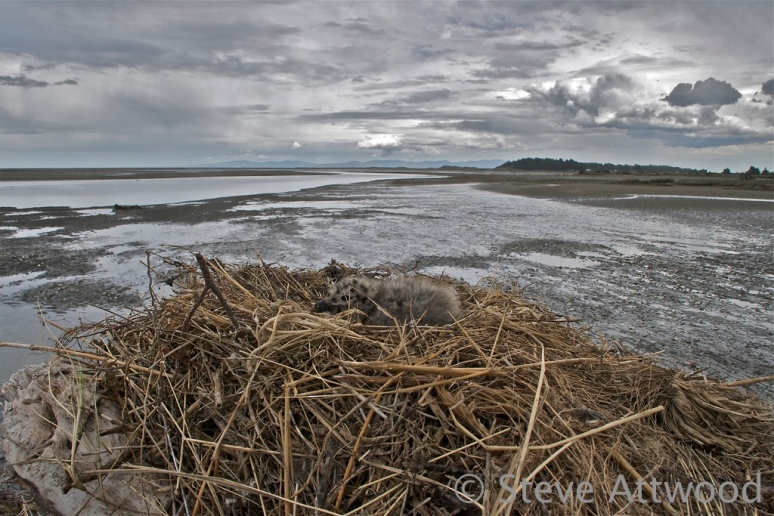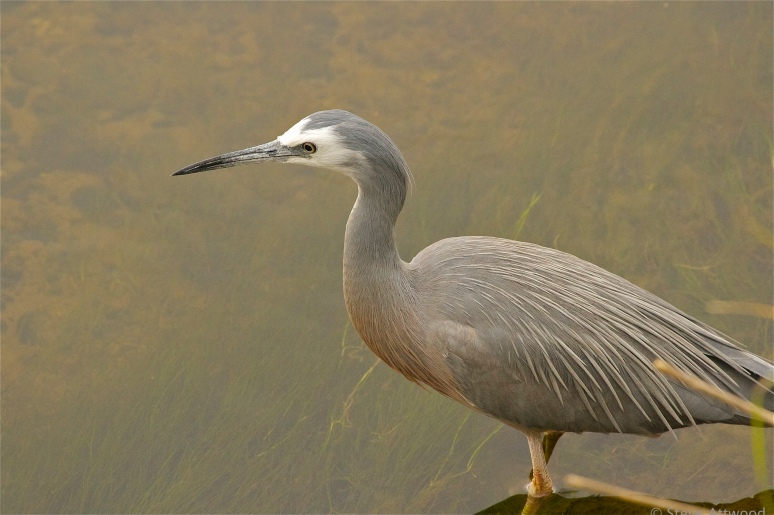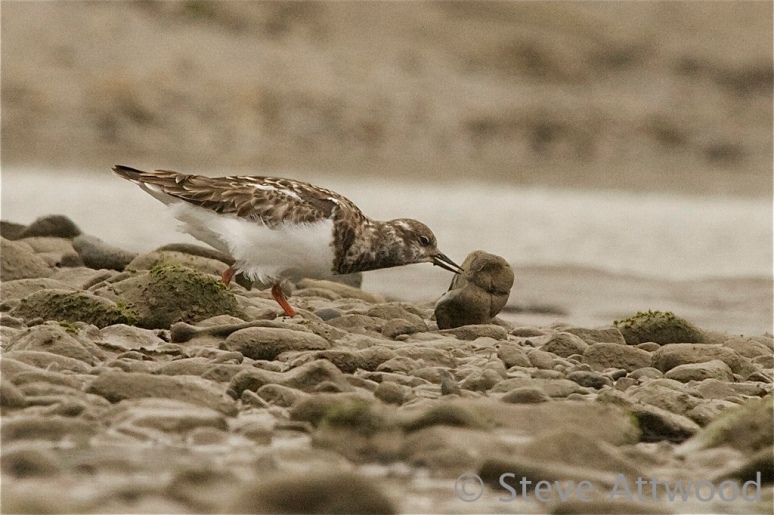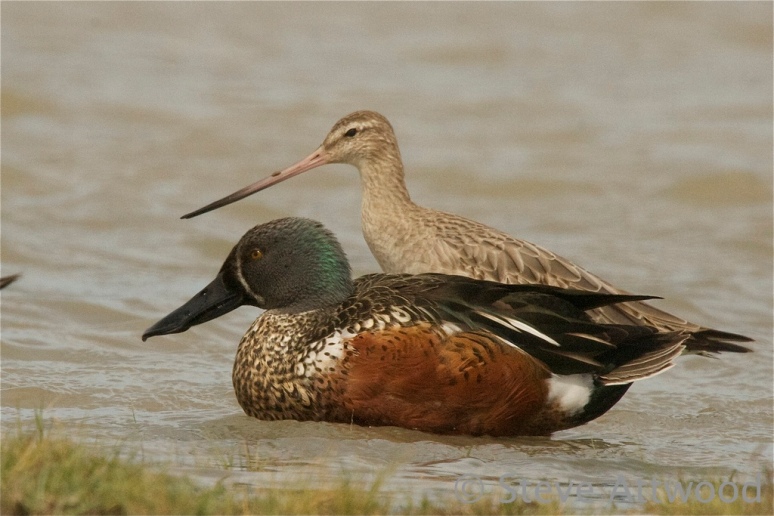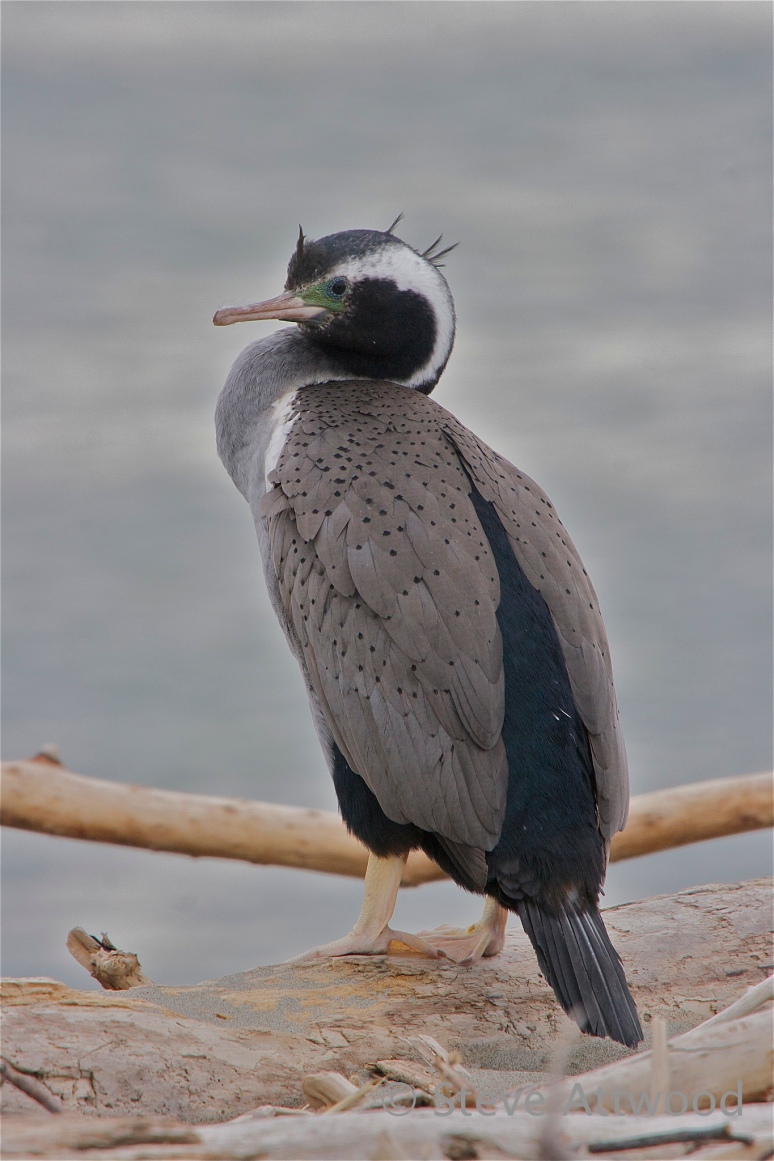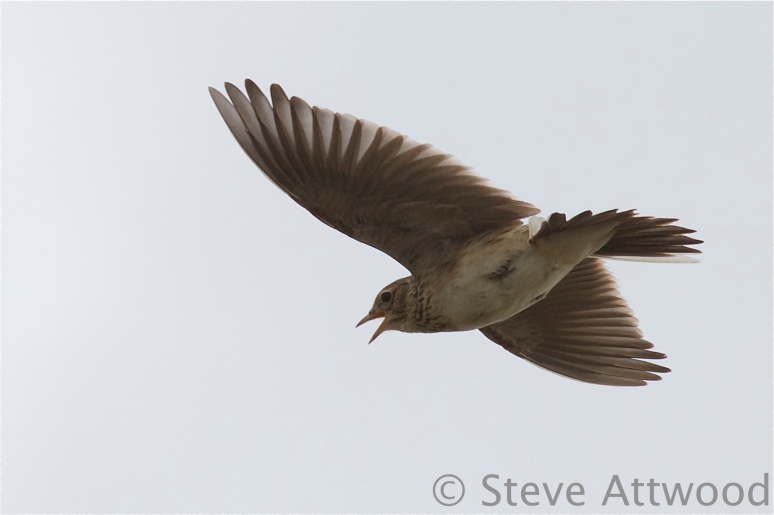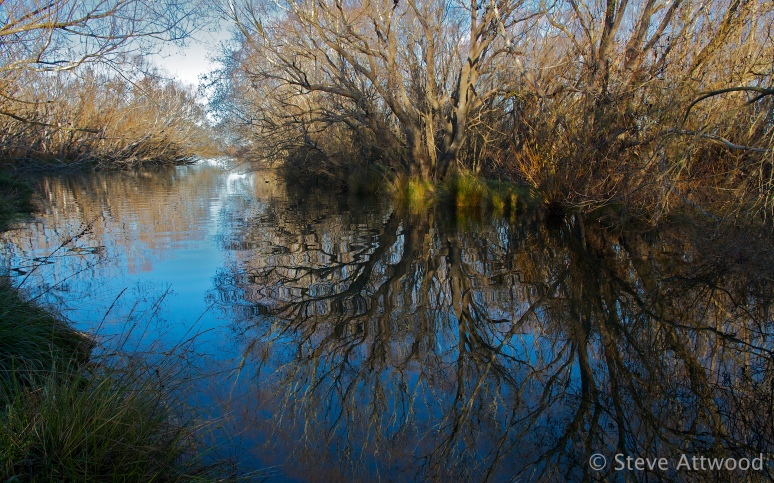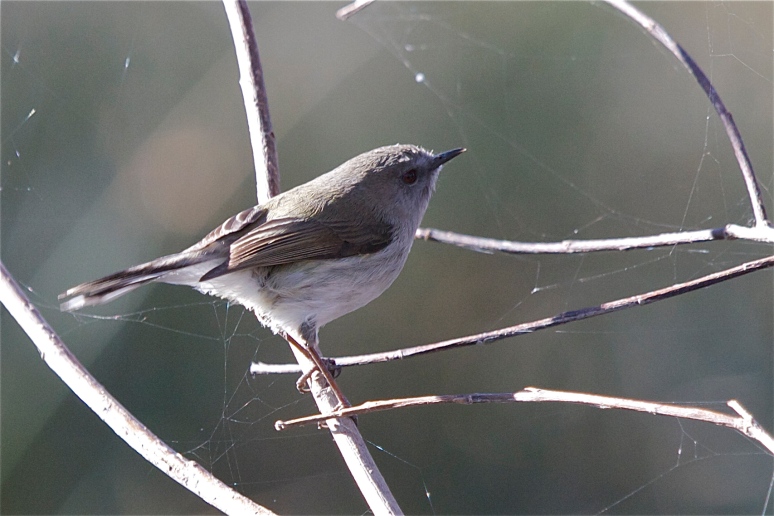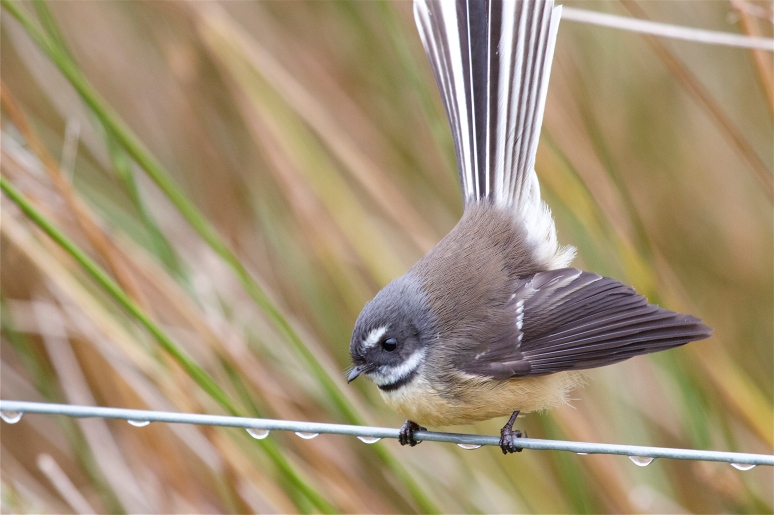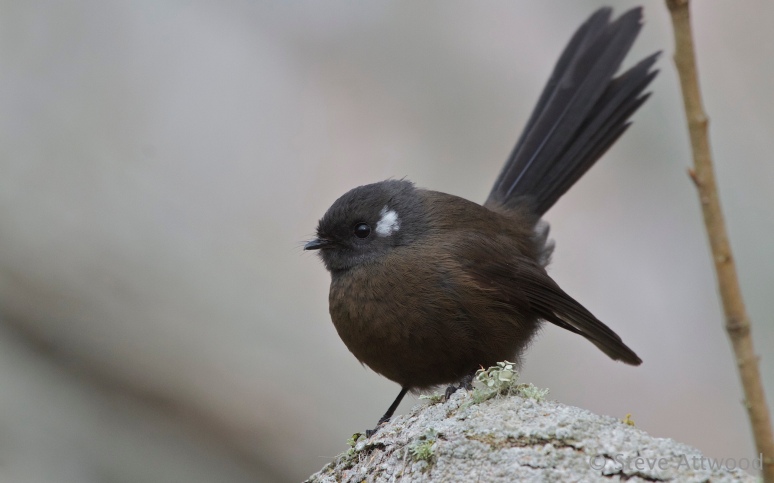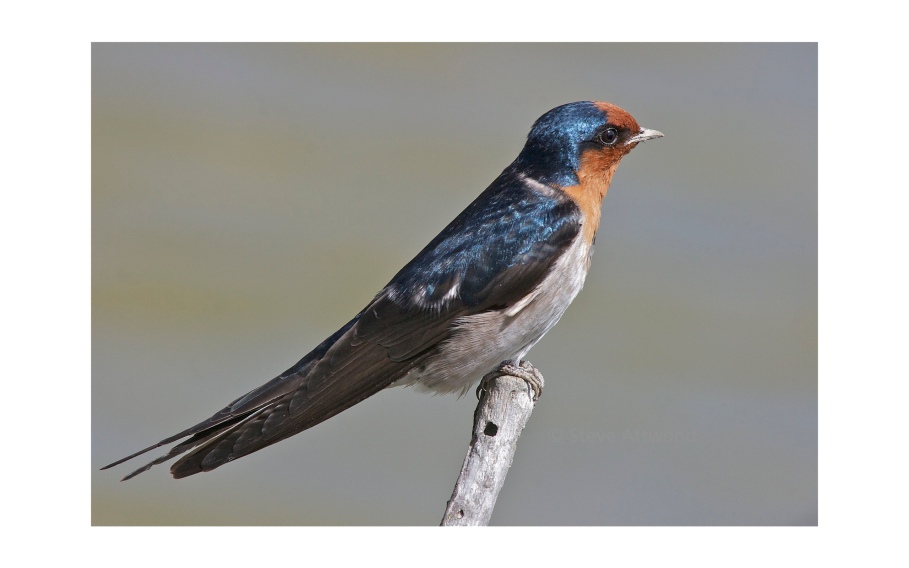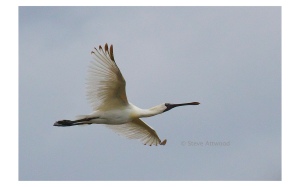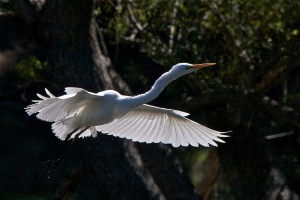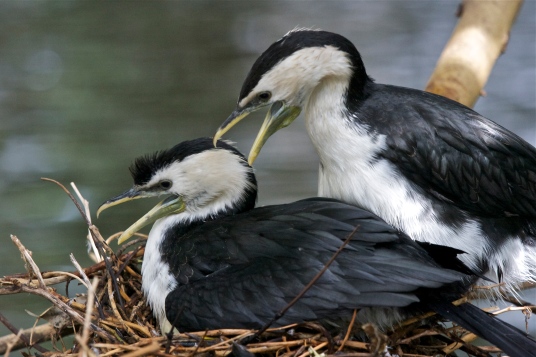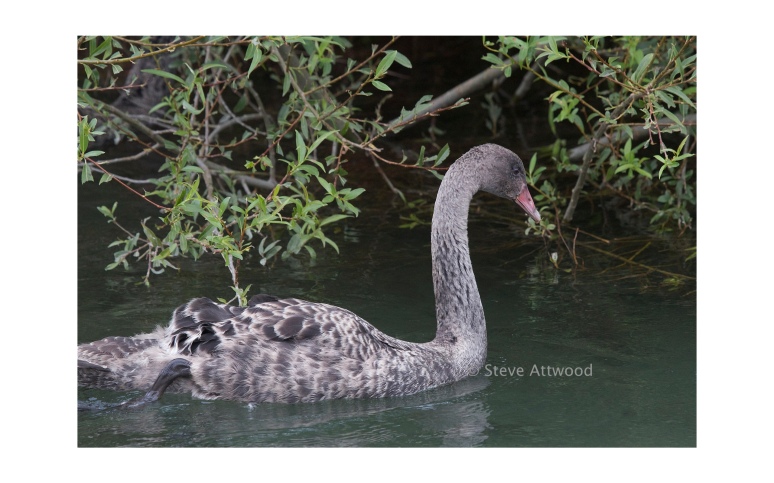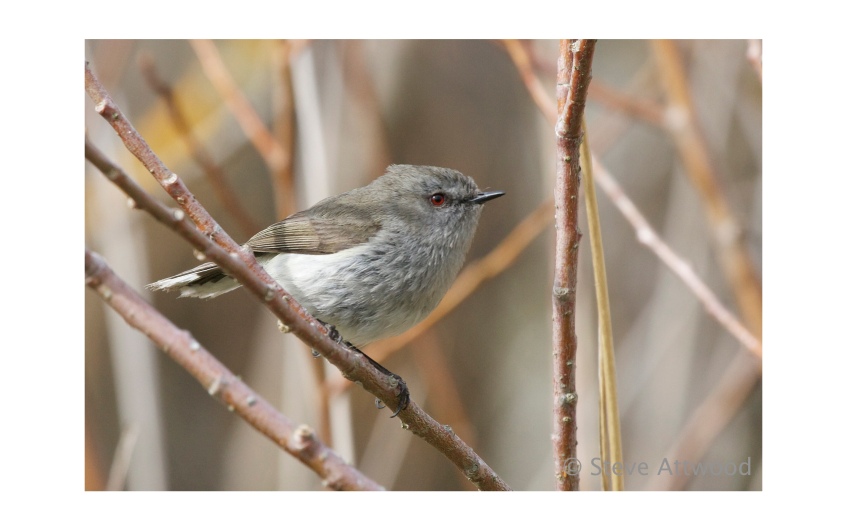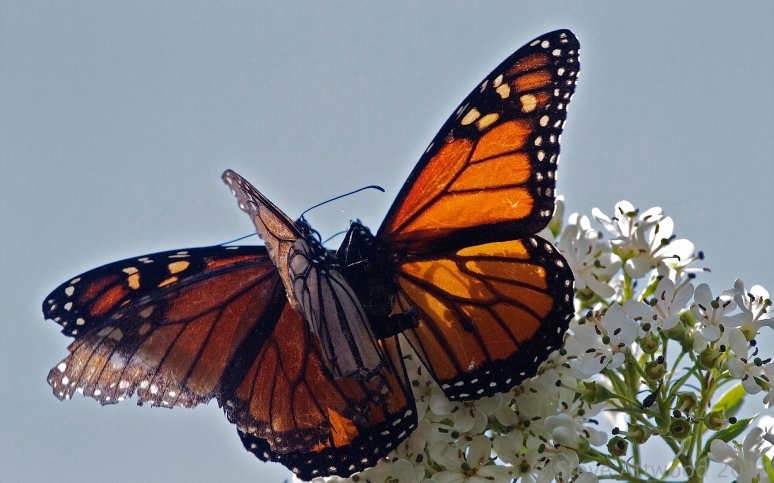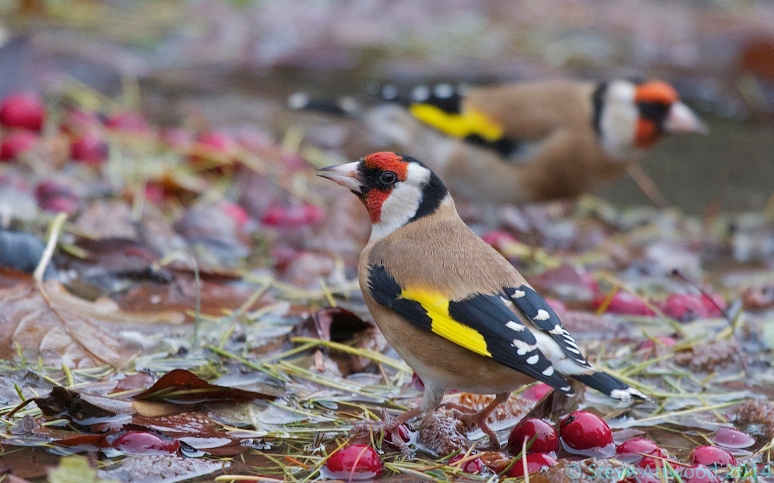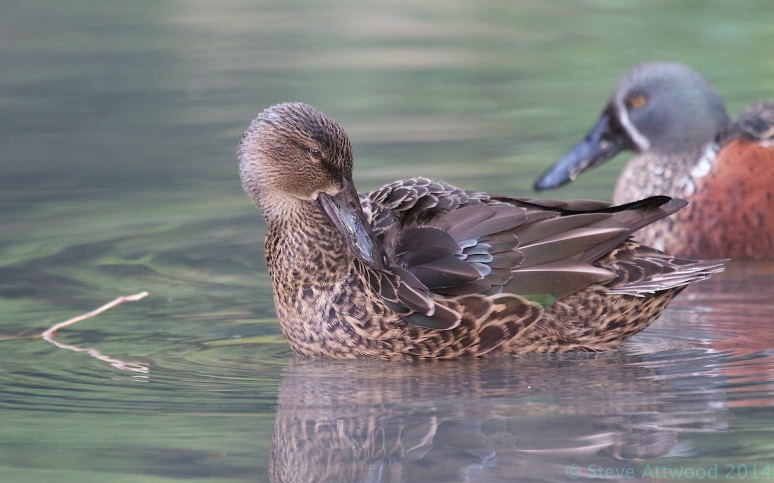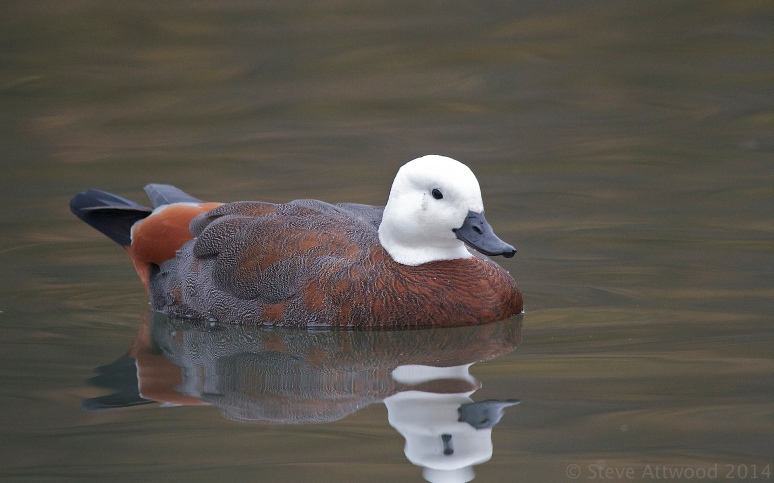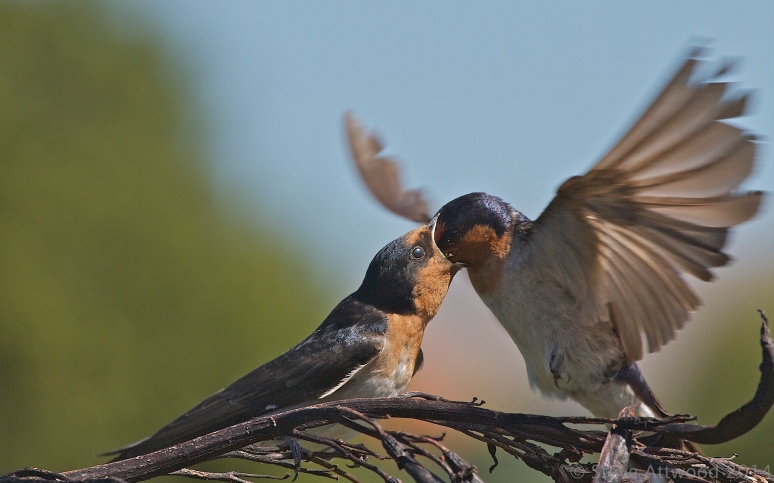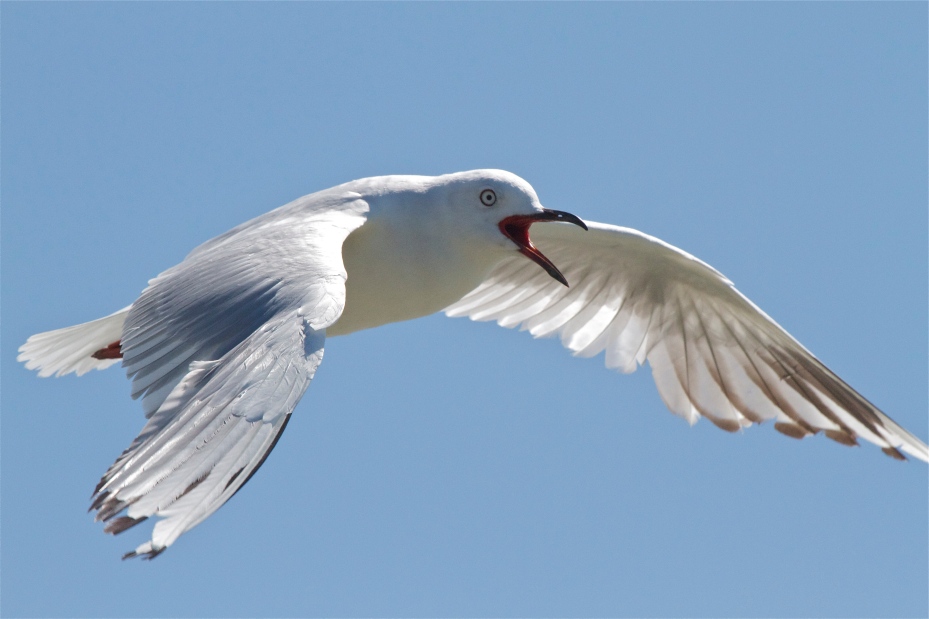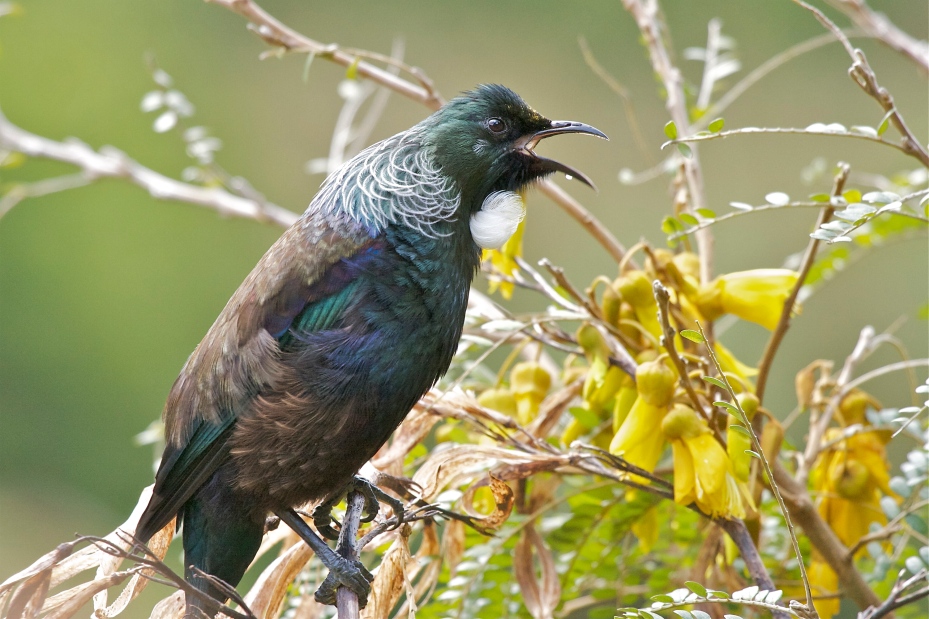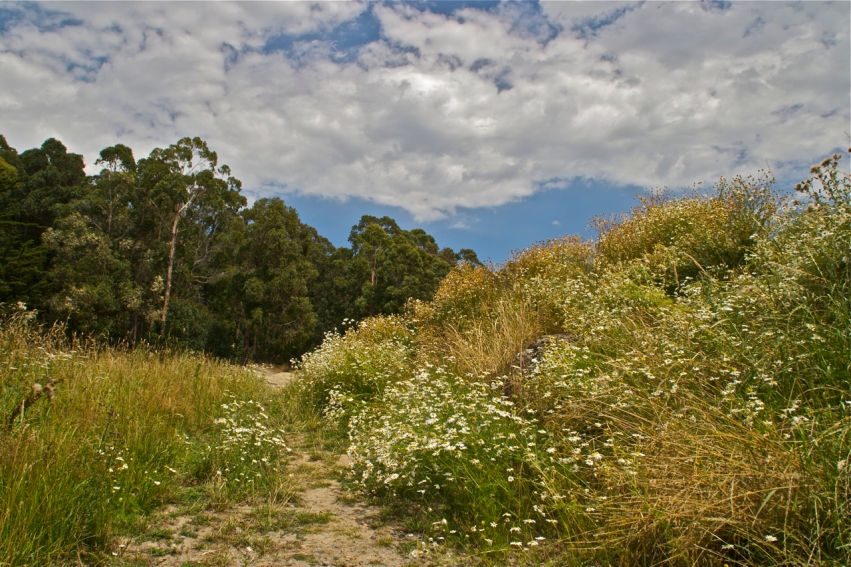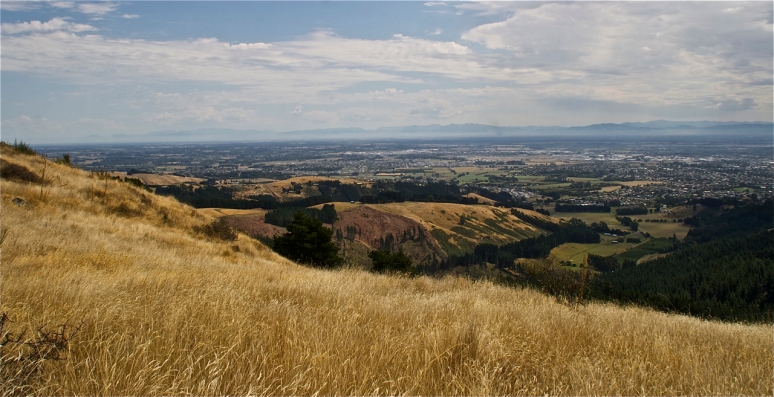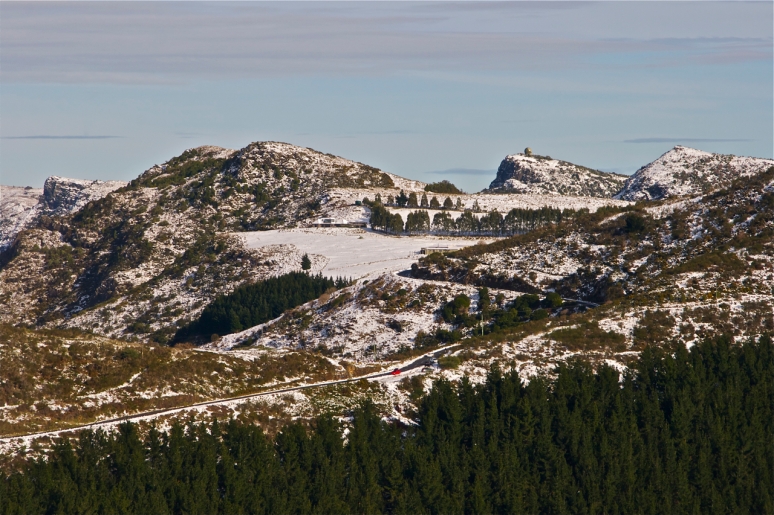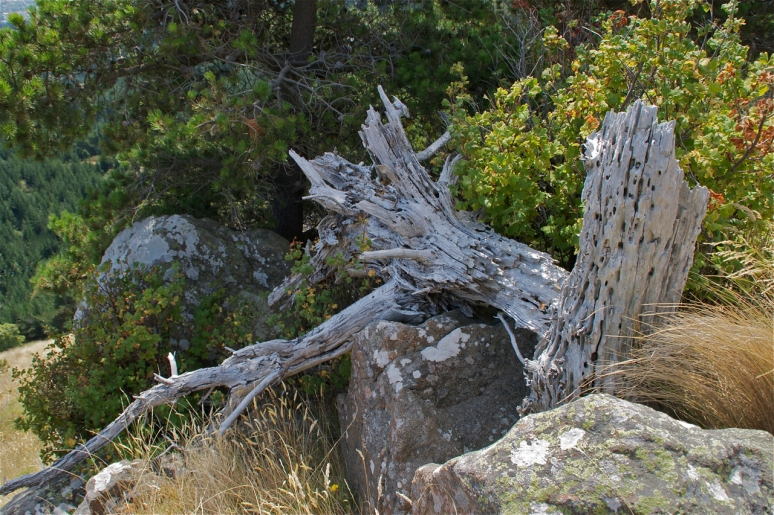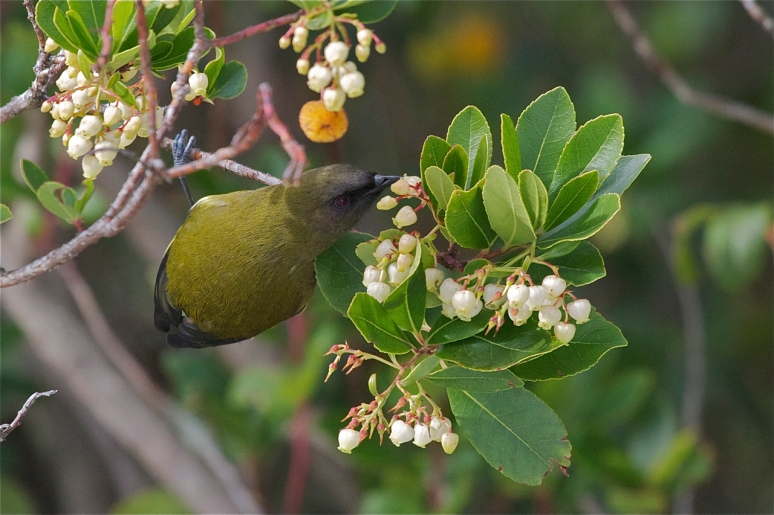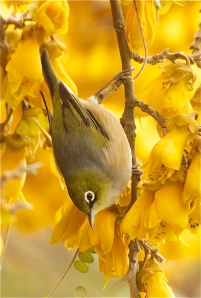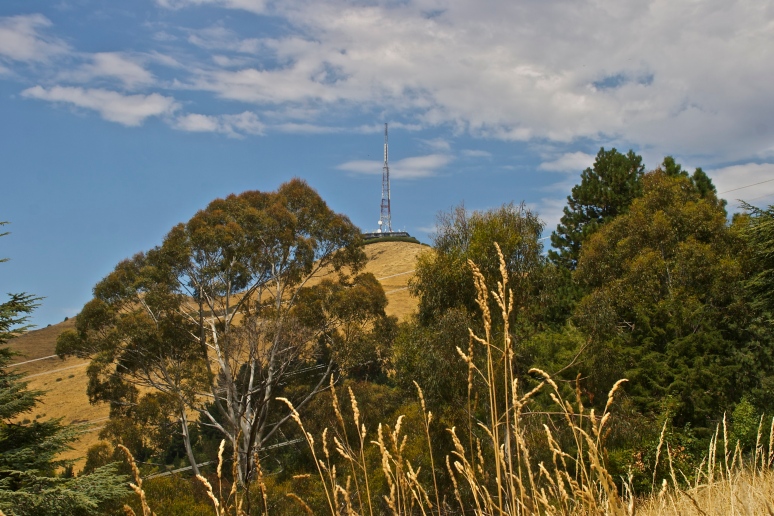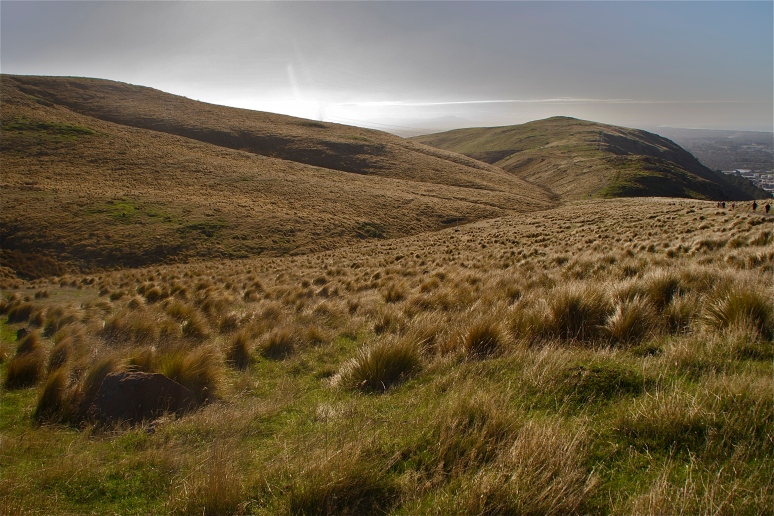Swallows of the sea

Tara and tarapirohe Ashley Estuary, Canterbury, New Zealand
“Sometimes they hover
motionless, high in a half-gale torrent of air
unmoved yet sustained by the stream that surrounds them
then,with no effort involved,
sudden and sharply they break
quick as a kite
when the string snaps
plunging down and across the sky” – an excerpt from The Pairing of Terns by Mark O’Connor

tarapirohe – adults in non breeding plumage and juveniles – take to the sky
Terns – the swallows of the sea. Elegant, swift, precise, bold and beautiful. I never cease to be in awe of them; they draw my eye and the focus of my lens at every opportunity.
My ‘bucket list’ ambition is to see and get good photographs of all of the terns that breed in, or visit, New Zealand. Considering there are some 14 or so species, and of these some are extremely rare visitors, or only occur on distant islands in our far-flung territorial seas, I have my work cut out for me. But it’s a worthy ambition!
Of the species recorded, one is classed as endemic and a few are endemic at the sub-species level. These latter include the rarest of our breeding terns, the fairy tern (Sternula nereis davisae), which has a ‘critically endangered conservation’ status and is, tragically, the most endangered of all of New Zealand’s endemic taxa.*
To date my bucket list of tern species seen and photographed has reached a total of five . . . only nine or so to go!

Tara – the white-fronted tern – Ashley Estuary
Tara – the white-fronted tern – Sterna striata – native – declining
I often encounter this tern in large numbers at the Ashley Estuary. When it does not have eggs or chicks, this is a very confiding bird allowing close human approach. They will happily carry on preening, feeding, courting, mating and roosting with a photographer within less than five metres. This all changes when they have eggs/chicks; then they are fierce defenders of their space and the photographer must be much more cautious to avoid disturbance.
Tara are the most common tern on the New Zealand coastline, at times occurring in flocks of many hundreds, even thousands of birds. It is mainly a marine species that is seldom found far from the coast.**


(left): Tara gathered on a jetty railing. Birds in such areas that are frequently visited by people become very tame allowing very close approach.
(right): Courting tara exchanging fish
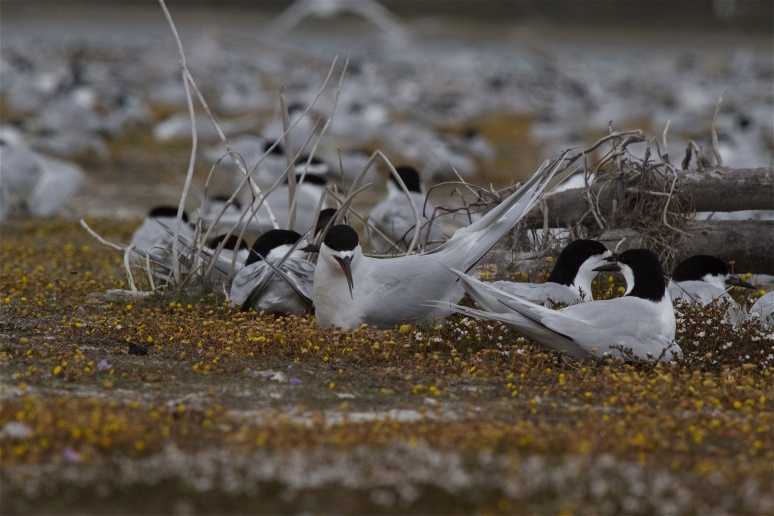
tara breeding colony – Te Waihora/Lake Ellesmere

A juvenile tara showing the striated plumage that gave this bird its species name
Taranui – the Caspian tern – Hydroprogne caspia – native – nationally vulnerable
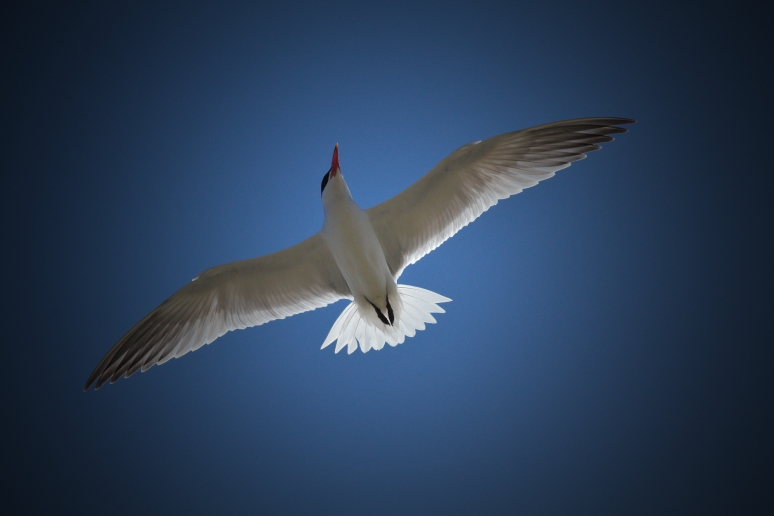
I often hear this, the largest of our terns, before I see it. Its harsh croak is a distinctive sound of estuarine areas and around the huge but shallow Te Waihora (Lake Ellesmere), which is a breeding stronghold of this species in New Zealand.
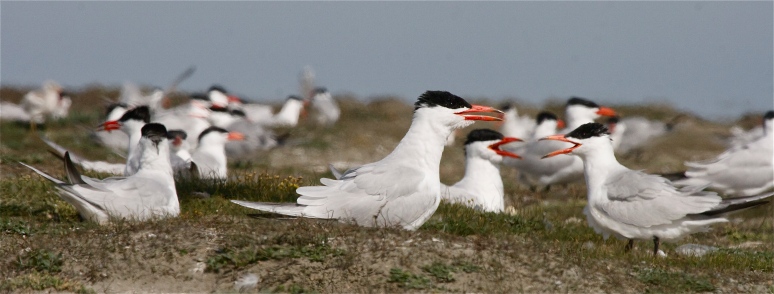
Taranui breeding colony – Te Waihora/Lake Ellesmere
In spite of its size it is a timid tern, very difficult to approach. But it will often roost with its bolder, smaller, cousins and that seems to give it more courage. And, once in the air fishing, it will pass very close to the photographer indeed, if you can work out its fishing ‘beat’ and position yourself accordingly.
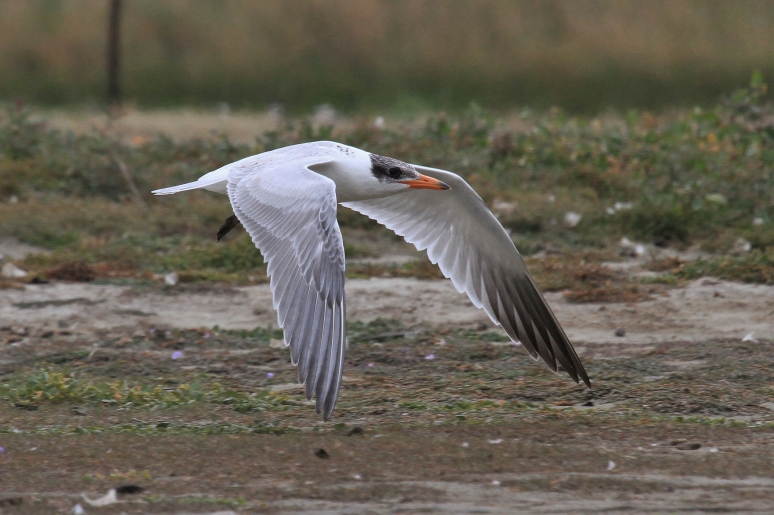
Taranui – non breeding plumage – Te Waihora/Lake Ellesmere
The largest of all species of terns (the Maori name taranui translates as ‘big tern’) the Caspian is a large distinctive gull-like tern of shallow coastal waters and, particularly outside of the breeding season, inland lakes and rivers throughout New Zealand.**

Tarapirohe – the black fronted tern – communal bathing
Tarapirohe – the black-fronted tern – Chlidonias albostriatus – endemic – nationally endangered
Of the terns I encounter regularly in my home province of Canterbury on the South Island’s east coast, the tarapirohe is a favourite. In mating plumage the adults are strikingly beautiful, but that is not the only reason I find them particularly appealing.

An adult tarapirohe in full breeding plumage
I am a passionate advocate for the protection of our unique braided river ecosystems. This is a rare ecosystem globally and New Zealand is the world capital, with Canterbury containing some 60% of the total area of braided rivers in New Zealand.
The tarapirohe only breeds in the eastern South Island’s braided rivers. Indeed, while it overwinters on the estuarine coasts, it is effectively an inland tern. It is often seen hawking over pasture and its nests (a mere scrape) among the alluvial stones can be found in riverbeds at the very foot of our highest mountains.

a few sticks, a small scrape, a tarapirohe nests among the braided river stones

Until they move, tarapirohe chicks can be almost invisible among the round river stones

A juvenile tarapirohe rises up from the water

Tarapirohe – non breeding plumage – with prey
The gull-billed tern – Gelochelidon nilotica – native – vagrant
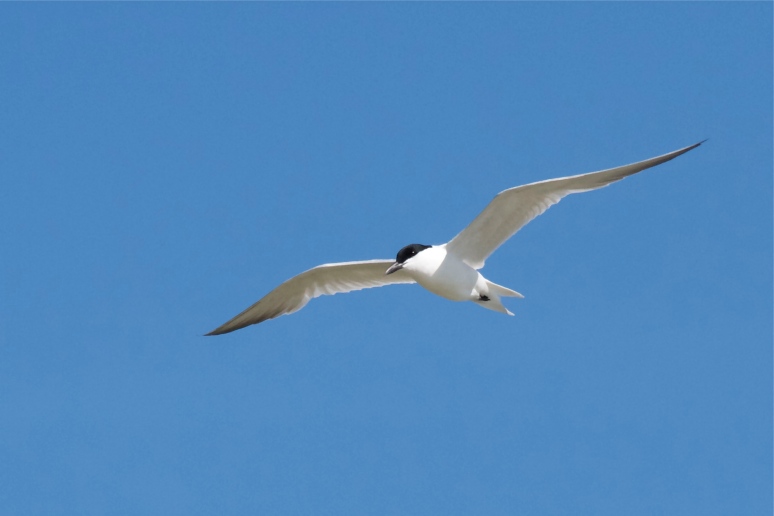
As with its bigger cousin the Caspian, the first, and only, time I saw this large tern, I heard it first, it’s call so similar to that of the Caspian I thought it was this species until it came closer. I was on the wide mud flats of Te Waihora (Lake Ellesmere), which is a site where gull-billed terns have been recorded semi-regularly, albeit in very small numbers. The birds (only four) circled me and were gone, but giving me just enough time to get a couple of shots.
Gull-billed terns are mainly birds of the Australian interior, appearing and breeding on temporary water left by floods. Gull-billed terns and other Australian wetland birds are often forced to find new habitats when the temporary wetlands are consumed by drought. It is during post-flood droughts that gull-billed terns are likely to reach New Zealand.**
The little tern – Sternula albifrons – native – uncommon migrant
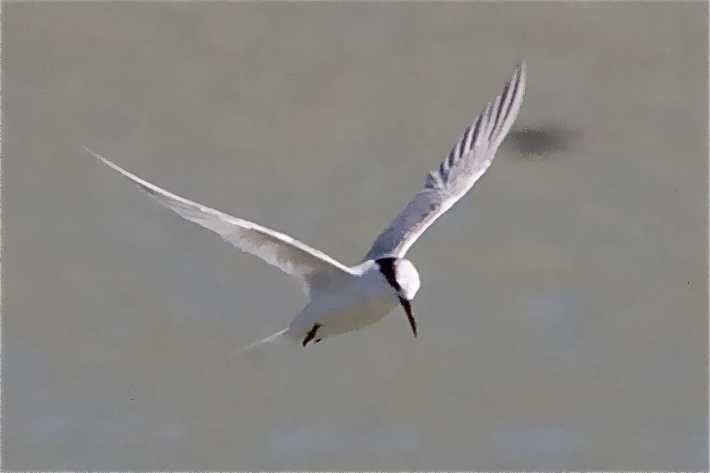
I was photographing gulls and terns on the wide shallows of Te Waihora (Lake Ellesmere) when I heard a bird call distinctly different from the birds around me. There in the distance was a very small tern hovering over the water, calling constantly.
A fruitless stalk followed, the flickering ghost of a bird kept its distance hiding in the heat shimmer over the lake. So my first, and only, photo of a little tern is a heavy crop out of a much bigger picture, verging on pixilation. But it’s the only photo I have to record this encounter with such a dainty little visitor and it will remain in my collection until the chance to take something better comes along.
Although small numbers of little terns visit New Zealand every year, it took some time before they were recognised as being New Zealand birds. They are very similar to the now rare fairy tern, especially in the nondescript non-breeding and immature plumages most often seen in New Zealand. Careful observations led to the presence of little terns being confirmed on the Miranda coast, Firth of Thames in the 1950s. By this time, the fairy tern had become one of New Zealand’s rarest birds, and the little tern is now known to be the commonest small tern in the country over the summer. **
Angles of light
I often think of terns as angels of light. When you can capture them against the light of the sky or a rising or setting sun, there is a glory about them that no great painter of religious icons can replicate.
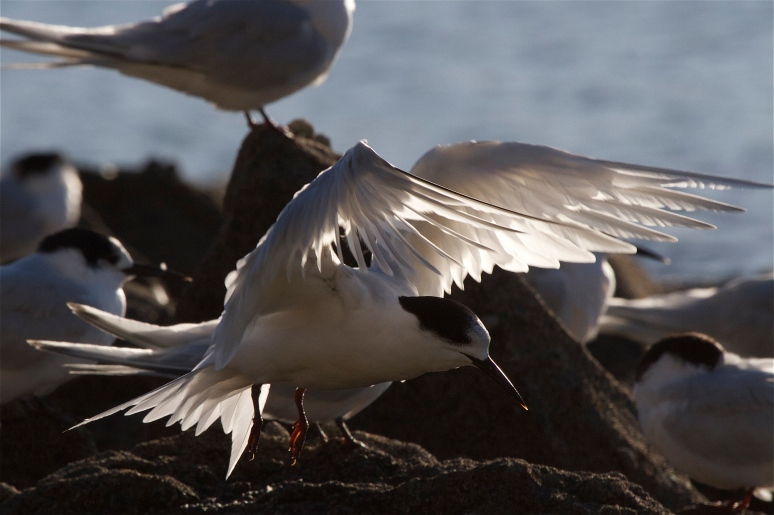
tara – white-fronted tern – an angel of light
*Birds of New Zealand – a photographic guide, Scofield and Stephenson.
Rakahuri manu
Rakahuri Manu – birds of the Ashley River
As September draws to a close the breeding season of New Zealand’s unique braided river birds is just starting to get into gear.
Early arrivals have been on the river since about mid-August, but most of the time since has been about finding a mate (or re-establishing an existing pair bond), finding a suitable nesting territory and defending it.
By now, however, these preliminaries are nearly over for the early breeders such as the ngutuparore (wrybill- Anarhynchus frontalis) and tuturiwhatu (banded dotterel – Charadrius bicinctus) and the serious business of laying and brooding is getting underway. For some of our other braided river specialists however, such as the tarapiroe (black-fronted tern – Chlidonias albostriatus) and tarapuka (black-billed gill – Larus bulleri) the finicky process of finding just the right shingle bank or river-stone island to nest on has only just begun.
But, whether already nesting or still scouting around for a likely spot, from the hills to the sea the Ashley-Rakahuri River is now busy with birdlife as both the permanent avian residents and the seasonal visitors embark on the crucially important business of reproduction.
Recently I presented a photographic exhibition featuring a birds of the river on a journey from the inland braided channels to the estuarine coast. The following is an edited reproduction of that presentation.

After feeding up at the estuary the ngutuparore (wrybill – Anarhynchus frontalis) are moving upstream and establishing territory
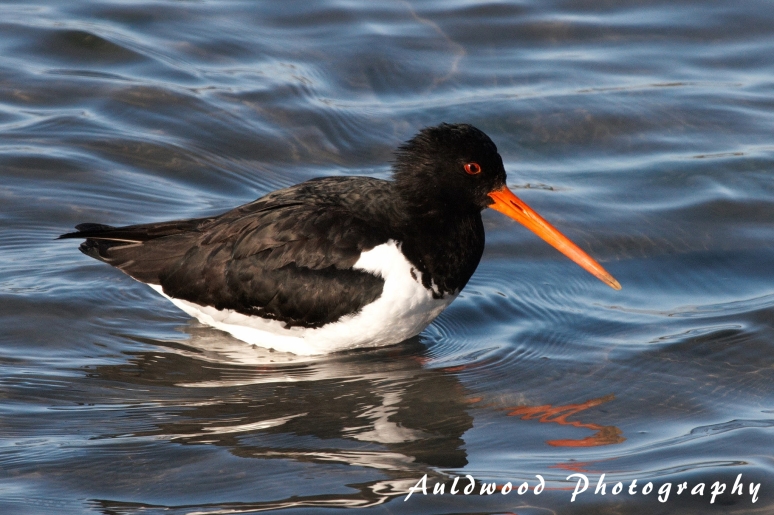
Torea (South Island Pied Oystercatcher – Haematopus finschi) are also establishing territory and defend it fiercely against all comers

Back in the willows the kawau-paka (little shag – Phalacrocorax melanoleucos) are still in the courting stage
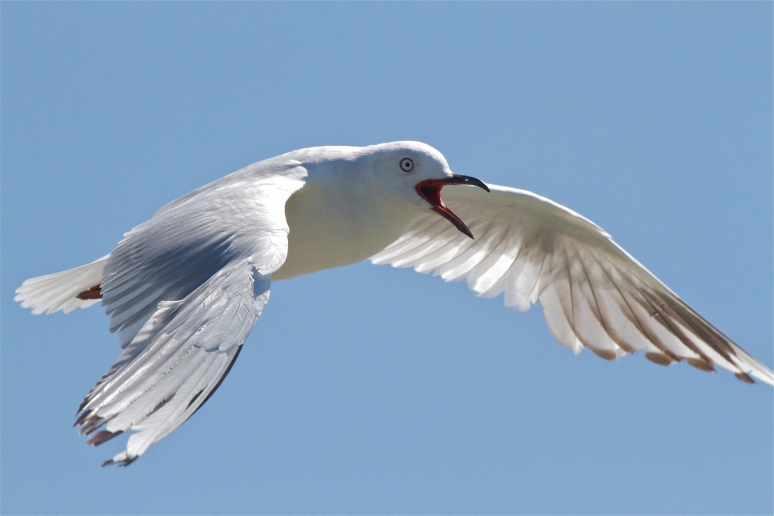
The tarapuka (black-billed gull – Larus bulleri) is fussy when it comes to establishing a nesting colony and often tries several spots before finally coming to some sort of mass agreement and the whole colony settles down to make nests, mate, lay and brood eggs.

The ubiquitous pukeko (Porphyrio melanotus) is not a braided river breeder but its communal nests, shared by several birds at once, can be found in the reed marshes bordering the estuary
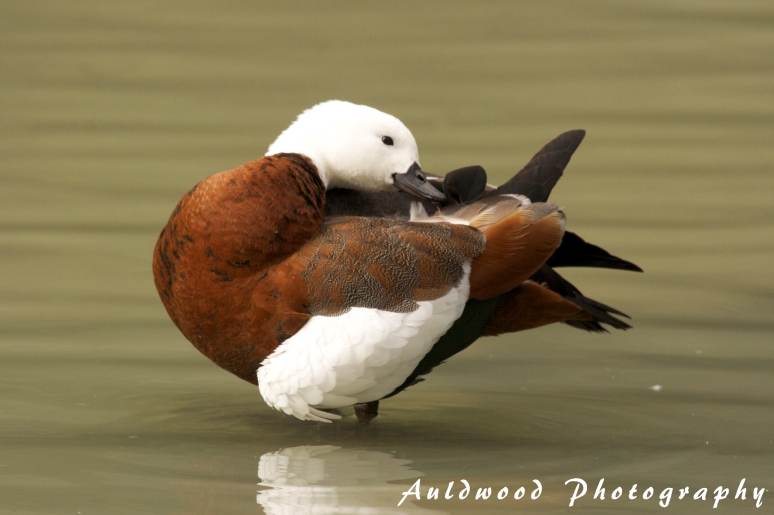
Putangitangi (Paradise shelduck – Tadorna variegata) are more cosmopolitan breeders, their nests found on the borders of the estuary and also well upriver among the braided river channels, usually on a more permanent island where there is some plant cover.
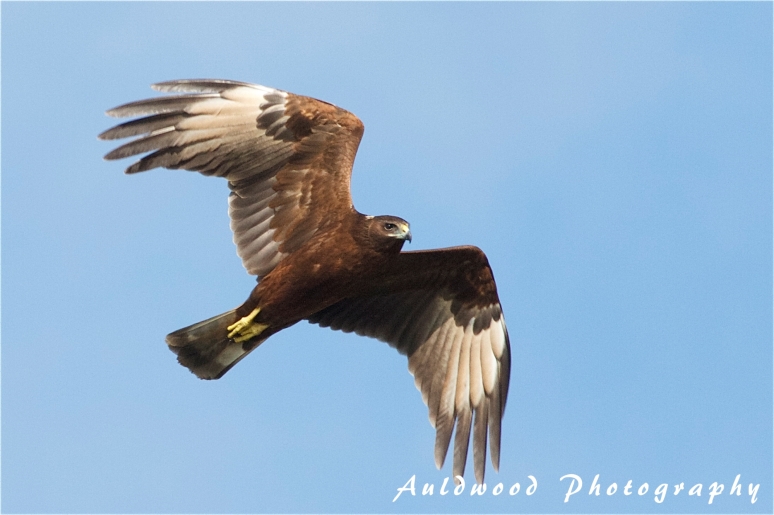
With all the young chicks soon to be hatching the kahu (swamp harrier – Circus approximans) times its own breeding to coincide with the increase in food supply. Almost every other species, no matter their size, will dive bomb or mob this fierce predator at every opportunity to protect their chicks
A season on the river
It’s hot.
The notorious Canterbury nor’ wester burns across the landscape sucking oxygen and moisture out of the air with equal ferocity. The stones of the Waimakariri riverbed warp and shiver in the reflected heat; mirages dance ephemerally in the air.
A rhythmic, breathy sound comes to me across the stones, as if some great beast lies nearby, gasping in the heat of the day. But this is not one beast . . . it is hundreds. Some 300 tarapuka in their riverbed colony, each black-billed gull standing over its nest, all panting in unison, holding steadfast in the sun to give their chicks a slim patch of shade. It is late November, the middle of the river season.
It was cooler when, on the Ashley-Rakahuri estuary, the arrival of the ngutuparore toward the end of August signalled the beginning of the river season. At first in twos and threes and then in dozens the wrybills turned up at the estuary after their long flight from over-wintering grounds far to the north. Hungry, and with breeding to build condition for, they fed in the tidal mud with the voraciousness of shrews. By October, all had moved inland to braided rivers where they could find the clean, weed-free, banks of river stones among which they build their shallow nests. A few pair simply head upstream on the Ashley-Rakahuri but others go further afield to Canterbury’s bigger braided rivers: the Waimakariri, Rangitata, Rakaia, and beyond.
Pohowera numbers also swell in August. Many of these hardy dotterels spend their whole lives on the coast, but those that breed inland on the braided rivers tend to migrate west to Australia. Splendid in their fresh breeding colours of red and black bands, they return in early spring to join the over-wintering locals to feed up, find mates and establish nesting territories. For much of the year, banded dotterels can be cautious birds, wary of too close an approach, but with spring comes hormone-fuelled courage. The males hotly contest for territory and established pairs are remarkably bold, especially once they have a nest to defend and will tolerate a patient photographer within two metres.
On the Ashley-Rakahuri estuary, flocks of tarapiroe (black fronted tern) have wintered over, along with their cousins the tara (white-fronted tern), taranui (Caspian tern) and the black-billed gulls. But as spring progresses these strikingly beautiful terns – capped in black velvet with road-code orange bills and legs – also head inland to share the clean river shingle with the wrybills, dotterels, black-billed gulls and the other braided river nesters. Some of their white-fronted cousins also choose to move inland, choosing higher shingle banks in the river, often near the added security of other bird colonies.
Some of the black-fronted tern nest in sizeable colonies alongside the black-billed gulls, which is a great strategy because the gulls are alert and ferocious sentries. But others scatter themselves along the Ashley-Rakahuri in small groupings of nests, wherever the shingle banks provide the right conditions.
There they are joined by the poaka (pied stilt), spur-winged plover, torea (South Island Pied Oystercatcher), and the karoro (Southern black-backed gull).
By mid November there are many voices on the river as the river nesters begin to hatch their young and attend to the task of feeding and raising their chicks.
Each has a different style.
The black-fronted tern do little more than scrape a hollow in the stones, perhaps adding a few rudimentary twigs or scraps of weed, but essentially their eggs lie directly on the stones. The stilts and oystercatchers use a similar tactic, with little if any covering over the stones to cushion the eggs.
Wrybills seem to be just as perfunctory in the nesting department, but a closer look reveals something remarkable – the tiny bowl they have made among the stones has been lined with very small pebbles . . . an exercise in remarkable patience and care!
The gulls, on the other hand, build actual nests. The black-billed nest is fairly basic but provides a platform of twigs and river detritus to give their eggs some cushioning. Their large cousins, the black-backed gulls, build substantial piles of tangled sticks and river weeds that seem unnecessarily large for the modest eggs cupped within, but this commodious affair is revealed as practical when the fast-growing chicks soon fill it to its borders.
The waders all have chicks that pretty much feed themselves from the moment of hatching, relying on their parents for protection and the lessons of life, but quickly learning to find for themselves the bugs and grubs in the river shallows. The terns and gulls are more solicitous, bringing food to the nests to feed the demanding chicks. Even when fully fledged, young tarapiroe will sit on the ground begging food from their parents. In tern colonies an overhead adult carrying a fish sets off a chorus of excited calling as each chick hopes it is their parent that has returned.
The gull chicks grow quickly and frequently form crèches in between their parents’ visits with food; bundles of down moving together around the colony and down to the river’s edge to bathe, swim and exercise their wings.
Wrybill, stilt, dotterel and plover chicks stick close to their parents, freezing to invisibility among the stones when a parent bird calls a sharp alarm. In the mixed colonies the alarm call of a stilt will have the same impact on the chicks of other species as it does on its own youngster, with all of the chicks hunkering down. This is an excellent tactic for aerial predators such as the kahu (Australasian swamp harrier) or the karoro glide on by, but is of little use against the introduced mammalian predators such as stoats and feral cats, which can hunt by smell as well as sight.

banded dotterel chicks are up and feeding themselves from day one but need their parents’ protection
Late summer finds chicks fledging all over the place and testing their hunting skills. Tarapiroe glide up and down the river, imitating their parents with quick dives from a near hovering flight to seize fish. At first they are clumsy and miss more often than not, but patience and repeated tries are finally rewarded.
By early autumn all of the birds that have managed to keep their young alive throughout the season, surviving unexpected floods and predatory attacks from natural and introduced predators alike – let alone disturbance by careless humans and their recreational vehicles – begin to depart; some in the company of their newly fledged teenagers, but others leave the ‘kids’ behind to fend for themselves before they, too, driven by instinct, gather together to flock to their wintering-over grounds on the coast, further north or across the Tasman sea.
The estuary becomes busy again now as the river breeders return to fatten up. Many, such as the black-fronted terns and the black-billed gulls, will stay, utilising the riches of the coastal waters to see them through the winter ahead. The wrybill all fly up north where they flock in their thousands along the coast of the Firth of Thames and in other northern estuarine areas. Some banded dotterel stay in their home territories on the coast, but those that have bred inland will return to the coast and many travel to Tasmania and southeast mainland Australia in an unusual east-west migration.
Stilts and plovers, too, have a mixed response to the approach of winter. Some stay put, others move to the coast, and still others make long flights to preferred over-wintering territories elsewhere in the country.
The river is not entirely abandoned though. Many stilts, dotterels and plovers remain, as do some of the gulls, and winter visitors also move in, including the kotuku that have left their breeding colony on the West Coast to scatter throughout the country in lakes, rivers and estuaries.
Soon, the perils of winter floods and frosts will pass, and spring will come around again. And then, just as the whitebait begin to come in from the sea, the river breeding specialists will return to trust their eggs to the stones and gamble again with the fickle floods of spring.
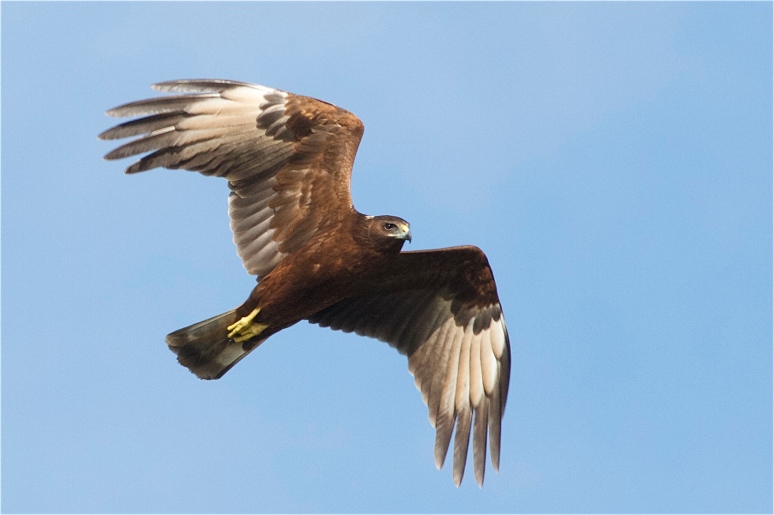
the magnificent kahu (Australasian swamp harrier) will have to wait until spring to brave the defences of the gull and tern colonies for another season of nest raiding
(All photos in this blog copyright Steve Attwood/Auldwood Photography. Permission must be sought for use, reproduction or copying in any form)
Wild in the city IV – the Ashley-Rakahuri
The criteria for my Wild in the City series is that the focus of each episode in the series be a wild place within or close to Christchurch City and readily accessible. The Ashley-Rakahuri River meets these criteria and more.
A little treasure – the Ashley-Rakahuri
There are far mightier braided rivers in Canterbury, but the modestly sized Ashley-Rakahuri is an ecological gem, a taonga* of a value disproportionate to its size.
For the most part the Ashley-Rakahuri weaves through highly modified rural farmland where indigenous natural New Zealand has almost been scrubbed from existence. But the braided river channels of the river itself are a largely unmodified natural environment that has been a unique feature of the Canterbury plains for eons.
Braided rivers are rare in the rest of the world, with New Zealand considered a hot spot, and Canterbury the centre of that, with 59% of the country’s braided river surface area. They are the home of highly adapted braided river specialists, chief among them being the birds.
The Ashley-Rakahuri is a smaller braided river and is rain fed, originating in the Canterbury foothills, rather than glacier-fed and originating from the eastern slopes of the Southern Alps as the dominant braided rivers of Canterbury such as the Waimakariri, Rakaia and Rangitata do. But what the Ashley-Rakahuri lacks in size it more than makes up for in variety. Among its labyrinthine waterways, dynamic shingle islands and stony banks breed some of the most rare and endangered birds in the world. In a relatively short span of riverbed quite close to the township of Rangiora nest three of the principle and most threatened braided river specialists: The black-billed gull (the most endangered gull in the world), the unique wrybill (under threat and the only bird in the world with a bill that bends sideways), and the beautiful black-fronted tern (also an endangered species).
Where the Ashley-Rakahuri reaches the sea, just 25km north of Christchurch, it spreads out into a large, generally unmodified estuary that is ranked as an internationally important wetland with a host of resident and seasonally visiting birds. It is a vital stopover site for birds migrating up and down the coast, and beyond; including the iconic kuaka (bar-tailed godwit) and other Arctic migrants that live out their winter in our summer.
Unfortunately, the ecological values of these braided river systems are increasingly threatened; most have been invaded by introduced weeds and introduced mammalian predators, and are further degraded by a wide variety of human activities. From its gorge, a popular swimming picnicking and fishing spot, to its mouth, the Ashley-Rakahuri, being so accessible and so close to Christchurch, is particularly vulnerable to these pressures. The numbers of birds along the river have declined and its ecological rating downgraded accordingly, from ‘outstanding’ to ‘nationally important.’

Safe among the stones? Like the other river breeding specialists, the banded dotterel is a threatened species at risk from human-caused environmental degradation
But, being so small in comparison to the bigger braided rivers, The Ashley-Rakahuri also offers a unique opportunity for effective intervention; initiatives to protect the river in places where the most threatened of birds are known to feed and breed – predator trapping, weed clearance, public education, vehicle discouragement and monitoring – are showing signs of at least stopping the decline of the endangered species, perhaps even reversing it.
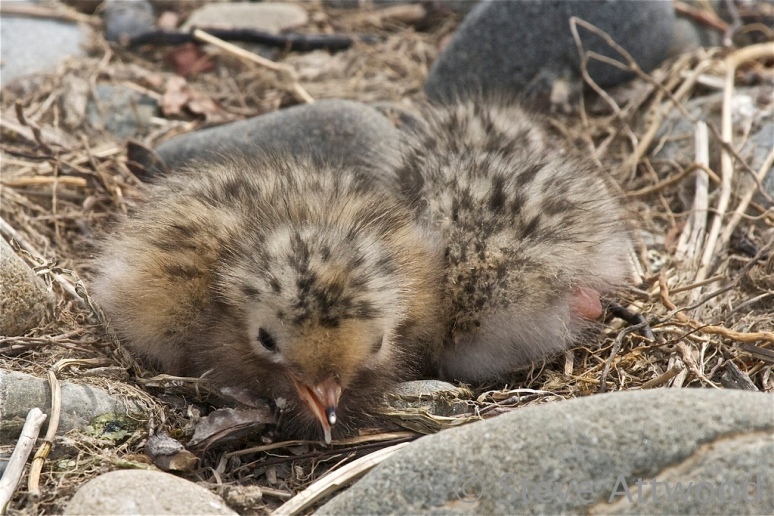
Trapping of introduced mammalian predators helps protect these vulnerable tarapiroe chicks hidden among the stones
While the protection efforts at the Ashley-Rakahuri focus on the wrybill, black-billed gull and black-fronted tern, many other bird species benefit. The braided river is home to such other key native species as the tuturiwhatu (banded dotterel – Charadrius bicinctus), the poaka (pied stilt – Himantopus himantopus) and the torea (pied oystercatcher – Haematopus ostralegus). The very rare kaki (black stilt – Himantopus novaezelandiae) has bred occasionally on the river in recent years (mated with a pied stilt) and over-wintering kaki are regularly seen in small numbers on the estuary.
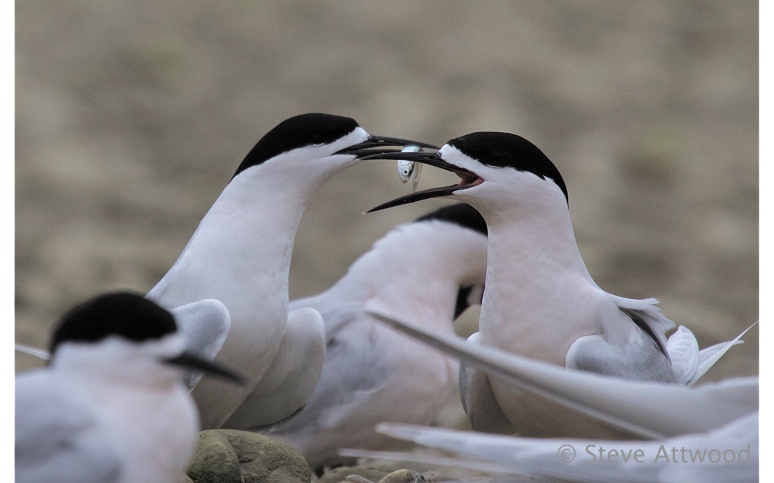
courting tara – white-fronted tern – share space on the Ashley-Rakahuri with their more rare black-fronted cousins
Migratory wading birds are the spring through to autumn stars of the estuarine environment. Here I have seen godwit, knots, whimbrel and turnstone.
The number of resident species at the estuary is also substantial. Along with the mudflats, dunes, sand and shingle banks are freshwater ponds and creeks, reed and raupo beds, scrublands and grassy flats, providing a multitude of environments for birds to live, breed and feed in.
The native birds I have seen along the Ashley-Rakahuri include: the shags (pied, little, spotted and black); the large waders (Australasian bittern, royal spoonbill, white heron and white-faced heron); the intermediate-sized waders (spur-winged plover, South Island pied oystercatcher and variable oystercatcher and oystercatcher hybrids); the waterfowl (black swan, grey teal, New Zealand shoveler, paradise shelduck, New Zealand scaup and Australian coot); the terns (black-fronted, white-fronted and Caspian); the gulls (red-billed, black-billed and southern black-backed); and the birds of the forest, air and riverbank (harrier, welcome swallow, kingfisher, grey warbler, silvereye, and fantail).
The estuary is also home to large number of introduced game birds such as mallard and Canada geese; and introduced field birds such as skylark, chaffinch, yellowhammer, redpoll, sparrow and goldfinch.
The above lists are by no means exhaustive as they are only my observations; other species are recorded as regular, occasional or rare visitors.
* treasure

A torea – South Island Pied Oystercatcher. The Ashley is known for being a place where SIPO and Variable Oystercatcheres hybridise.
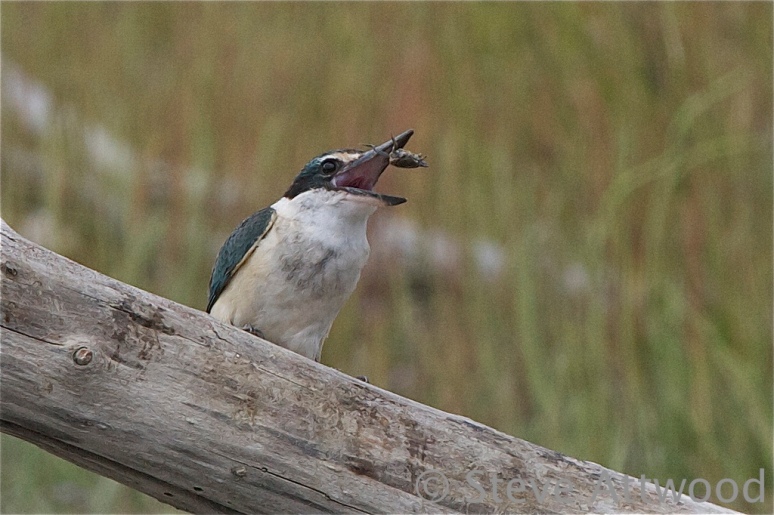
Kotare – the sacred kingfisher – favours the estuary but can also be seen upriver perched above the deeper pools

Kawaupaka – little shags – also nest on the edges of the estuary and hunt its waters – they are regularly seen upstream as well hunting within the deeper pools
Wild in the City III – Harts Creek
Christchurch New Zealand is blessed with a variety of places where pockets of wildlife, especially our birds, continue to thrive. I’ve decided to feature these places in a series titled ‘Wild in the City’
Harts Creek – small but perfectly formed
I’ve gone big, yet small, for this third article in the series and stretched the rules a tad.
Big yet small? The broad location of this nature’s gem is Te Waihora/Lake Ellesmere, New Zealand’s fifth largest lake – some 20,000ha with approximately 75 kilometres of shoreline; but I want to focus on the ‘small but perfectly formed’ Harts Creek, a tiny but special piece of this giant wetland jigsaw of natural and modified land forms.
Te Waihora is a shallow, brackish lake on the Canterbury coast. At its north end it does, indeed, come within the boundaries of Christchurch city. So the lake itself meets my “Wild in the City” criteria. The most important wetland habitat of its type in New Zealand, Te Waihora and its surrounds provide a home and/or feeding ground for a large range of bird, reptile, plant and invertebrate species.
The low–lying lands between the Selwyn Delta and the Halswell River are important for large populations of waders; the Kaituna Lagoon/Birdlings Flat area is important for waterfowl. Some 160 bird species have been reported on the lake and up to 98,000 wetland birds use the lake at any one time; at least 37 species of which breed there. Forty-three species of fish have been recorded from Te Waihora and its tributaries. Species on the Kaitorete Spit, which separates the lake from the sea, include endemic plants, reptiles and insects found nowhere else.
On the western edge of this vast wetland (outside of the boundaries of Christchurch city but close enough to fit my ‘rules’ for this blog) Harts Creek flows through developed farmland and empties into the lake at the Harts Creek Wildlife Management Reserve. This small wildlife refuge and the creek are an excellent example of the cooperation for conservation that can occur between landowners and authorities. The creek runs through private land, but the owners have done more than allow access; they have supported the re-planting of the riparian boundaries with native vegetation, and fenced off the banks from stock. There is a boardwalk to provide secure footing through the swamp that culminates in a bird hide built by the Ellesmere Lions Club, giving views across the secluded lagoon–like bay that comprises much of the reserve.
The entire route, from road–end to hide, is a bird watcher’s paradise, with the observable species changing with the seasons.
I list the species I have observed on the Harts Creek route below but let me mention some highlights.
Unusual as it is for me to focus on introduced species, the Ellesmere population of mute swans is one of the few places in New Zealand to see these birds in a truly wild state (as opposed to semi-domesticated birds in city parks). These graceful and striking swans frequent Harts Creek, their white plumage a stark contrast to the shaded gloom of the closely wooded sections of the waterway.
Another favourite is the ever-cheerful riroriro for which Harts Creek is a population stronghold. Our second smallest native bird, this little warbler has a voice that belies its size; its high–pitched trill a happy herald of spring. The sound is uplifting and penetrating, but finding its tiny owner is a real challenge as these grey denizens of the forest are difficult to see, they flit so quickly among the branches.
Another forest inhabitant is the ubiquitous piwakawaka, as at home in urban gardens as in native forest. Because humans disturb insects into flight this little fan-tailed predator seems to seek out our company. It flies about our heads to snatch up the prey we stir up. Prolific breeders, piwakawaka can suddenly burst into large numbers in the spring and their merry chirping sounds like a thousand kisses being stitched into the air.
In the open areas – above water or paddock – the warou compete with kotare for iridescent beauty. These swift hunters catch insects on the wing and are indeed, as their English name suggests, a welcome sight. Forgot not the kotare however, as still–sitting as the swallow is fast moving, it spies down from branches above the creek and then darts like a rainbow-shafted arrow to seize its prey.
Harts creek has its mysteries too, none more so than two of its more secretive residents, the impressive matuku and the diminutive koitareke. The bittern is rarely seen unless one is prepared to visit just on dusk and sit very still indeed. But in spring and early summer the sonorous booming of the males echoes around the hide even during the day. It shares this habitat with the tiny marsh crake, another twilight zone bird. But sometimes the visitor will hear it in daylight hours, it’s ‘click click click’ calls quite distinctive. Though shy, it is curious and a successful imitation of its call can sometimes tempt it from the lakeside reeds for a quick peek before it darts away again, its cryptic plumage making you wonder if you have really seen it at all.
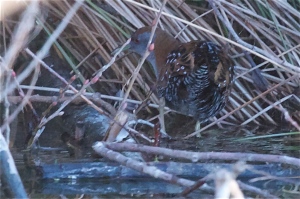
my only photo of the elusive koitareke is very poor quality, the bird was in deep shade, a long way away and moving fast, but I was so proud of it, some photographers will never see these shy birds let alone get any sort of photo!

The elusive matuku is also difficult to get good quality photos of. My ambition this spring is to get to Harts Creek and do better by exercising more patience and perhaps a little cunning
More regularly seen than the shy bittern are its fellow waders, the splendid kotuku-ngutupapa and the rare kotuku – royal spoonbill and white heron. Both large white waders, these birds ply the shallows of the reserve often close to the hide. The royal spoonbill wade in synchronised groups, sweeping their bills side to side in balletic choreography. They have recently begun breeding on Te Waihora often, ironically, on top of duck–hunter mai-mais. Numbers peak over spring and summer. I once counted more than 200 in a flock at Harts Creek Reserve. The white heron, by contrast, is a solitary stalk-and-strike hunter, more likely to be seen on the lake in the autumn and winter. From spring through summer these birds gather at their only breeding grounds in New Zealand, hundreds of kilometers away on the South Island’s West Coast.
On the lake itself, observable from the hide, are many water birds but, for me, none have the appeal of the puteketeke, the Australasian crested grebe. Near the limit of its natural range in New Zealand, the puteketeke has suffered, like so many native birds, from the introduction of mammalian predators and habitat destruction. They survive mainly in the eastern lakes of the South Island high country but a few migrate to more coastal waters for the winter. Some have stopped returning to the high country and now breed at Ellesmere and nearby Lake Forsythe. At Harts Creek several pairs build their floating nests among the raupo bordering the lagoon; if one stays very still, they adjust to the presence of humans and will come well within observable and photographic reach. With their splendid crests and elaborate mating displays they are a delight to watch; their zebra–plumed youngsters even more so.
There are many other birds to delight the eye and heart along the Harts Creek walk. It’s easy grade and family friendly. Take the kids, persuade them to be quiet by giving them a task to see how many species they can see, and enjoy!

The kahu is the dominant aerial predator on Te Waihora / Lake Ellesmere and builds its nest in the dense raupo near Harts Creek
Native birds I have observed at Harts Creek
(Note, these are species I have seen and photographed, there are others. Also, the species range on Te Waihora/Lake Ellesmere as a whole is much wider. For example, Harts Creek does not have the extensive mudflats that attract many of the migrant waders elsewhere on the lake).
Black-billed gull – Larus bulleri
Kahu – Australasian harrier – Circus approximans
Kakianau – black swan – Cygnus atrattus
Karoro – southern black-backed gull – Larus dominicanus
Karuhiruhi – pied shag – Phalacrocorax varius
Kawau – black shag – Phalacrocorax carbo
Kawaupaka – little shag – Phalacrocorax melanoleucos
Kereru – New Zealand pigeon – Hemiphaga novaeseelandiae
Koitareke – marsh crake – Porzana pusilla
Korimako – bellbird – Anthornis melanura
Kotare – sacred kingfisher – Todiramphus sanctus
Kotuku – white heron – Ardea modesta
Kotuku-ngutupapa – royal spoonbill – Platalea regia
Kuruwhengi – Australasian shoveler – Anas rhynchotis
Matuku – Australasian bittern – Botaurus poiciloptilus
Papango – New Zealand scaup – Aythya novaeseelandiae
Piwakawaka – fantail – Rhipidura fulginosa
Poaka – pied stilt – Himantopus himantopus
Pukeko – Porphyrio melanotus
Putangitangi – paradise shelduck – Tadorna variegata
Puteketeke – Australasian crested grebe – Podiceps cristatus
Riroriro – grey warbler – Gerygone igata
Spur-winged plover – Vanellus miles
Taranui – Caspian tern – Hydroprogne caspia
Tarapunga – red-billed gull – Larus novaehollandiae
Tauhou – silvereye – Zosterops lateralis
Tete – grey teal – Anas gracilus
Warou – welcome swallow – Hirundo neoxena
White-faced heron – Egretta novaehollandiae
Introduced birds
Blackbird – Turdus merula
Canada Goose – Branta canadensis
Dunnock – Prunella modularis
Goldfinch – Carduelis carduelis
Redpoll – Carduelis flammea
Sparrow – Passer domesticus
Thrush – Turdus philomelos
Yellowhammer – Emberiza citrinella
Mallard duck – Anas platyrhynchos
Mute swan – Cygnus olor
Wild in the City part II – The Groynes
Christchurch New Zealand is blessed with a variety of places within the city boundaries where pockets of wildlife, especially our birds, continue to thrive. I’ve decided to feature these places in a series. This is the second.
The Groynes
The dictionary defines a groyne as a wall or jetty built out from a riverbank or seashore to control erosion, and it is just such a prosaic structure that has given its name to one of Christchurch city’s wild treasures, The Groynes Park.
The area now occupied by Christchurch was once part of a vast wetland of rivers and streams, artesian springs, swamps, small lakes, grasslands and native forest that abounded with life, especially birds.
With the arrival of European colonists came drainage for farming and settlement and the ‘taming’ of rivers within stop banks. As a result, nearly all that wetland has gone save for a few precious small and isolated remnants. The Groynes, though highly modified with exotic planting and groomed parklands, are one such remnant.
The groynes themselves were made from concrete-filled woolsacks. The sacking has long since rotted away leaving these squat, odd-shaped ‘bales’ around which surge the clear waters of the spring-fed Otukaikino Creek.
Along the borders of this creek has been created The Groynes Park. Weirs and excavations have created a series of long pools and small lakes and low falls that spill through a large area of exotic plantings, mostly poplars and willows, mixed with remnants of native forest. In spite of the large groomed lawns for picnickers and sport, and the manicured banks of the artificial lakes, much of the Groynes has a wild feel to it. Trees grow thick and un-pruned, the water is dark in their shadow and blackberries, bracken fern and ivy run rampant through the undergrowth, making progress all but impossible except on the designated paths.
Now, the landscapers have gone full circle. Their predecessors removed the forest and drained the wetlands, replacing kahikatea, matai, toetoe and harakeke with pines, eucalypts, alders, hawthorn, rowan and cotoneaster. Today’s gardeners are re-planting the native species and restoring marshy wetland; their long term vision to see the return of some semblance of the rich Canterbury plains wetlands with their tall swamp forest trees and associated wetland species (plants, birds, fishes, reptiles and insects).
What is wonderful is that this eclectic mix of exotic and native plants sited in a blend of natural and human-created landscapes, is home to a remarkable array of animals, especially birds. In this world, too, exotic rubs shoulders with endemic. The European song thrush and blackbird root through the forest floor while a metre or so above their heads piwakawaka flit around, picking up the insects the larger birds have disturbed into flight.
The tiny silver-voiced riroriro cares not whether it hangs its nest from the flimsy limbs of a juvenile kowhai, or among the protecting spines of the hawthorn. Kuruwhengi glide across the ponds alongside introduced mallards, though the native bird distains the offerings of bread from visiting children that the mallards greedily devour. With re-vegetation of native species continuing, this mix of native and endemic species is continuing to develop.
On any given day the park rings with the joy of recreating humans barbecuing, playing ball, kayaking on the lakes, walking their dogs and fishing from the ponds. And, right beside them, the bird photographer can delight in a list of species that is impressive for a green island on the edge of a large urban environment.
On the water the native species include kuruwhengi (Australasian shoveler), tete (grey teal), papango (New Zealand scaup), black swan, coot, kawau (black shag) and kawaupaka (little shag).
Flitting over the ponds’ surface warou (welcome swallow) can be seen and kahu (Australasian harrier hawk) patrol the skies.
Pukeko wade the edges of the streams, kotare (sacred kingfisher) spy down from overhanging branches, and kereru (New Zealand pigeon) pluck the tender shoots of kowhai and willow alike. A lone koitareke (marsh crake) – ultra secretive birds – has also been reported.

pukeko will as readilly take the ducklings of exotic mallard as graze on the native pond weeds and shore grasses
The native forest birds include riroriro (grey warbler), piwakawaka (fantail), tauhou (silver eye), korimako (bellbird) and, in the spring, pipiwharauroa (shining cuckoo).
Rare native bird visitors include karearea (New Zealand falcon), matuku (Australasian bittern) and kotuku (white heron).
Three species of gull also visit The Groynes, including the black-billed gull, which is endemic to New Zealand and the most endangered gull species in the world.
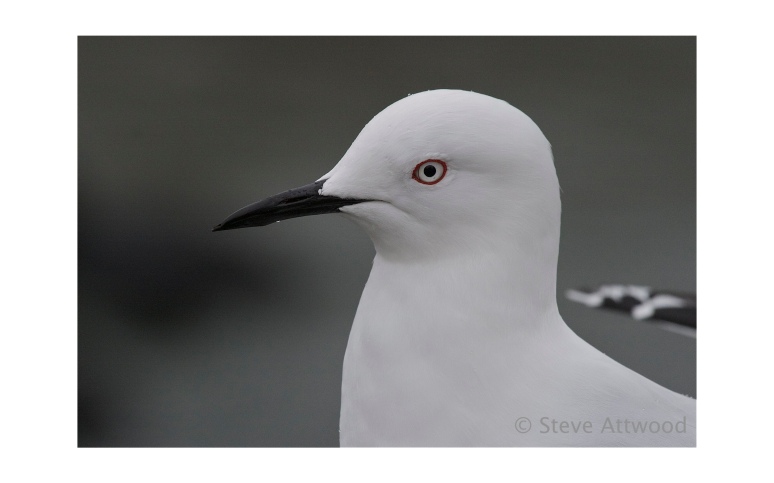
the black-billed gull rests and bathes at The Groynes and feeds in nearby fields where it takes insects and grubs from pasture
Their exotic companions include mallard, domestic geese and ducks, Canada geese, redpoll, chaffinch, goldfinch, greenfinch, sparrow, dunnock, blackbird, thrush, Australian magpie, feral pigeons, starling, yellowhammer, cirl bunting (an uncommon and visitor) and skylark.
The objective for future plantings is to contribute to and maintain the park’s historical features, maintain wide open spaces and create new variable sized spaces, enhance the ecology of the riparian edges, and provide native habitat and ecological interest. This will improve ecological values and recreation for future generations.
Wild city part 1
Wild City (part 1)
Christchurch is blessed with a variety of places within the city boundaries where pockets of wildlife, especially our birds, continue to thrive. I’ve decided to feature these places in a series. This is the first.
One of the real taonga (treasures) of wild Christchurch is, perhaps, unexpected, given that it is in the heart of the city and is a totally human created landscape. Well over one million people a year visit this place, yet it is possible to find unique New Zealand fauna thriving there.
Those who know Christchurch will, by now, have guessed that I am referring to Hagley Park and, within that park, the Christchurch Botanic Gardens.
At 164.637 hectares, Hagley Park is the largest urban open space in Christchurch. It was created in 1855 by the Provincial Government, which decreed that it be “reserved forever as a public park, and shall be open for the recreation and enjoyment of the public.”
Of course, with a provincial Government bent on recreating ‘Mother England’ (Christchurch is famed for being the most English city outside of England) Hagley Park is showcase of introduced trees, mown grass fields dotted with feature trees, sports grounds and a manmade lake where youths (and the young at heart) would sport with their model sailing boats. The banks of the Avon River winding through it have been shaped to please the landscaper’s eye.
In a loop of the Avon River, bordered on three sides by the green expanse of Hagley Park, are the Christchurch Botanic Gardens. Some 1.1 million visitors come to the gardens each year, making them one of the city’s most popular attractions. They are regarded as one of the finest collections of exotic plantings in New Zealand. Such is their age that those early trees planted by the English pioneers (beginning with a single oak) are now venerable giants casting their shade wide across the manicured lawns or leaning imperiously over the river as if they had always been there.
But not all of these gardens are an exotic salute to the gardener’s art. Natives have been encouraged back along the river banks; indeed following the recent earthquakes we have seen new shallow wetland bays created and filled with indigenous plants along the inside of some of the Avon’s bends, where water birds might once again build their nests.
And near the river’s edge of the Botanic Gardens a large section of New Zealand natives has been planted and enhanced over the years and now represents a significant native collection in its own right. On the scale of things it is a comparatively small area, but it is wonderfully varied and enjoys the presence of many mature tall trees with their associated under-storey plantings; a ‘small but perfectly formed’ example of the indigenous vegetation that once covered thousands of hectares in the vast wetland that was Otautahi long before it ever came into the sight of European town planners’ eyes and received it’s religious moniker.
This is a perfect place to wander. It is an isle of peace in spite of it attracting so many people within its boundaries every day and being surrounded by wide avenues humming with traffic.
A summer stroller might be lulled by the gentle ripple of the languid river, the solid thwack of a cricket bat on ball and the clear laugher of children in the playground pool. A spring visitor will pause to admire the daffodils, breathe deep of the smell of the season’s first cut grass and hear the whiz of cyclists freed from scarves, gloves and balaclavas. Autumn revelers will dash through piles of rustling leaves and thrill to the long low light glowing softly through the yellow orange brown red leaves. In winter a crackling frost greets hardly golfers on the wide greens and ice may tinkle under the drooping riverside sedges.
But in any season gardens and park will chime, chirrup, cheep, chirp, coo and quack, for – perhaps because of its wide variety of landscapes, ecosystems and plants – they are a haven for birds; exotic, native and endemic. Fantails flicker as happily among the silver birches and oaks as they do among the kahikatea, ti kouka and manuka. Bellbirds drip their silver notes from deep yellow kowhai or from atop the tallest northern hemisphere pines. Kereru swoop from tall kahikatea to gorge on the spring tips of willows. A rare karearea swoops at speeds up to 200 kph onto feral pigeons.
In many ways this mixed landscape of native and exotic is the new, New Zealand ecosystem. The introduced has been here long enough to become established and the locals have adapted. European starlings feed on the nectar of harakeke and perform exactly the same pollination role as tui or korimako; pukeko tear down the heads of introduced cocksfoot to strip the seeds between their razor-edged bills; kotare are as happy to take goldfish as inanga.
Of course, the birds do not live on thin air. The park and gardens provide an abundance of insects, seeds, fruits, nectar, worms and other invertebrates.
Water plays a special role in both park and gardens. The Avon river winds through both and borders the gardens in a wide loop overhung with harakeke and willow, ti kouka and oak, kowhai and birch. The ubiquitous mallard is a feature here but also three beautiful New Zealand ducks, the wide-billed kuruwhengi, the sensationally-coloured putangitangi and the real life rubber ducky, the papango.
You might also have to say that warou (welcome swallow) could be classified as among the park’s water birds too, for they are never far from it and are often seen skimming at speed just above the surface of ornamental ponds and Avon River alike.
I cannot ignore the introduced passerines. Finches, sparrows and dunnock, blackbirds and thrush, yellowhammer and cirl bunting (to name a few). Their songs add to the aural beauty of this inner city ecosystem.
This is the beauty of Hagley Park and the Christchurch Botanic Gardens; this comingling of native and exotic. It is a delightful paradox. At once tamed and groomed, entirely the creation of human gardeners; and yet it is, truly, also a wild place . . . wild in the city.
Native birds I have observed in Hagley Park and the Christchurch Botanic gardens (there might be others):
Kahu – Australasian Harrier – Circus Approximans
Karearea – New Zealand falcon – Falco novaeseelandiae
Karoro – Black-backed gull – Larus domincanus
Kawau – black shag – Phalacrocorax carbo
Kawaupaka- little shag – Phalacrocorax melanoleucos
Korimako – bellbird – Anthornis melanura
Kotare – Sacred kingfisher – Todiramphus sanctus
Kuruwhengi – New Zealand shoveler – Anas rhynchotis
Kereru – New Zealand pigeon – Hempihaga novaeseelandiae
Papango – New Zealand scaup – Aythya novaeseelandiae
Pipiwharauroa – shining cuckoo – Chrysococcyx lucidus
Piwakawaka – South Island fantail – Rhipidura fulginosa
Putangitangi – Paradise shelduck – Tadorna variegata
Riroriro – Grey warbler – Gerygone igata
Spur-winged plover – Vanellus miles
Tarapunga – Red-billed gull – Larus novaehollandiae
Tauhou – silvereye – Zosterops lateralis
Torea – South Island pied oystercatcher Haematopus finschi
Wharou – welcome swallow – Hirundo neoxena
gentle serenade of flight
Sail, bright boat, winged banner, in my verse. Stitch, body of silver,
your emblem across the shirt of the icy firmament.
Oh aviator, gentle serenade of flight, snow arrow, serene ship in the transparent storm,
steady you soar, while the hoarse wind sweeps the meadows of the sky.
(extract from Ode to the seagull, Pablo Neruda)
What plight, the gentle serenade of flight?
It is hard to understand how we humans can write so beautifully in admiration of the gull as Neruda does, or how we can send the book and the film Jonathan Livingston Seagull to the top of the charts yet also be the species that generated the headlines above.
What possesses us to engage in such brutality? How can someone walk up to a colony of gulls and deliberately raise a stone above a nest of helpless chicks and smash it down? What sickness is it that causes someone to thrill to enticing gulls with food, shooting just to stun and then run over their living bodies with a car? What is in the head of a person who drives through a colony of eggs and chicks, distressed parent birds keening about their windscreen, and call it fun?
And, most perplexing of all, what has the gull done to earn such hate?
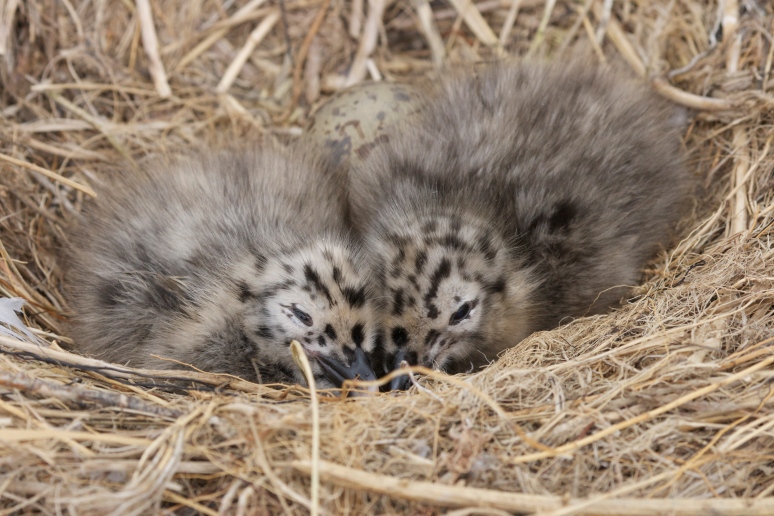
How can someone raise a stone above a nest of chicks and bring it smashing down? (karoro chicks – Larus dominicanus)
As a passionate bird photographer and conservationist I find it hard to understand how anyone cannot see the beauty in the silver flight of a gull. Or not experience awe at their precise aerobatics; perhaps experience a tinge of envy at their sleekly groomed perfection even in the face of a gale?
But too often we hear: “gulls are a pest”, “fucking scavengers”, “lamb killers”, “food stealers”, “flying rats”.
Most gulls are, indeed, opportunists, many successful animals are. But it is the habits of humans that create the problem; the bird is simply looking for an easy feed, a quality that most humans can surely identify with. So when they gather at the outdoor restaurant table, or swarm over open rubbish tips, surely the question we should be asking is not “will someone rid us of these pestiferous birds?” but rather, “what have we done to cause this behaviour and how can we fix it?” When animals become ‘pests’ it is almost inevitably the behaviour of humans that is the root cause.
Gulls do not flock to tips that are well managed and covered quickly; they soon bore of restaurants where food is cleared as soon as the table is vacated and where patrons don’t encourage them with a surreptitious scrap under the table. And as to lambs, studies show the infamous black-back rarely, if ever, kill healthy living lambs. They do, however, take placentas or docked tails, or feed on carcasses of lambs that have died from other causes.
Perhaps it is because there is something in the human psyche that looks down upon scavengers. In New Zealand the swift falcon is admired but the largest and equally handsome raptor in our skies, the swamp harrier, is derided as being “nothing but a bloody scavenger”.

New Zealand’s black-billed gull, the most endangered gull in the world, yet people have, more than once, attacked this colony.
But I don’t think it can be so simply explained as merely a cultural dislike of scavengers, this savage brutality toward other species that we humans display; seemingly for no reason other than some apparent bloodlust. For, it is not just gulls that are the victims of it. In New Zealand we’ve seen more than one attack on seal pups and they hardly fit the scavenger label, indeed are popularly seen as ‘cute ‘n cuddly’.
Sometimes our persecution of animals is because we perceive animals to be a threat to our own prosperity: the magnificent kea, the world’s only alpine parrot, was shot in the thousands because of a very few attacks on sheep; the black shag was hunted almost to local extinction because they had the nerve to eat trout that we wanted to eat ourselves.
This selfish attitude, too, can only be a part explanation, because sometimes cruelty to animals seems to have no motivation other than the act itself and whatever perverse gratification its perpetrators receive from it. Indeed, such cruelty can be counter to the perpetrator’s interests, such as when a farmer deliberately harms the animals that produce his income.
At this level, cruelty to animals gets scary. There is evidence that it can be an indicator of, or precursor to, the same person ‘progressing’ to human victims.
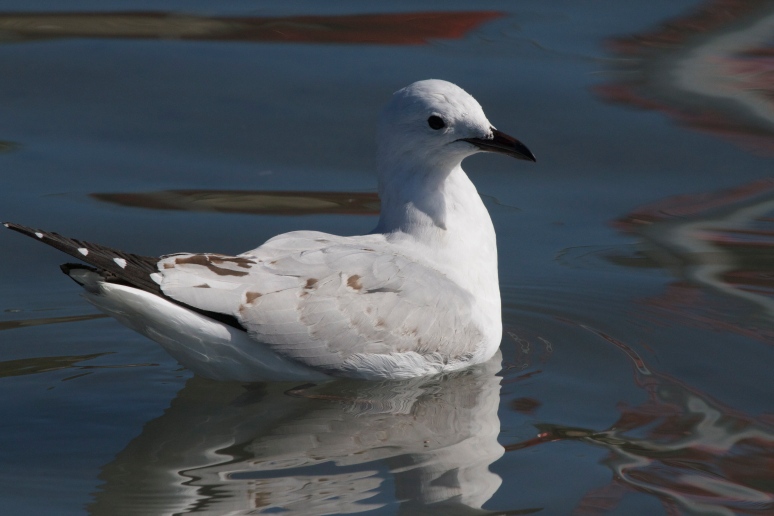
A “restaurant scavenger” in it’s natural setting is a glorious bird (juvenile tarapunga – Larus novaehollandiae)
We can probably do very little to prevent the deep-seated psychosis that drives pathological cruelty, but at least this is comparatively rare. But much of human kind’s distressingly more common ‘casual’ cruelty to animals is enabled, I believe, by social apathy and attitudes that seem to condone or even imply tacit approval. Fisher, hunting, and rural communities, for example, too often clam up when harm is done to animals because they don’t want to dob in their neighbours and mates, or bring their industry or recreation into disrepute.
“It’s just a few bloody gulls,” is a response I heard from one driver when I remonstrated with another 4-wheel-drive owner roaring through a protected gull colony; an attitude that is, unfortunately, widespread. Never mind that the birds in question were the most endangered gull species in the world!
Until there is community ownership of, and appreciation for, the animals that share our recreational spaces, cruelty will be enabled because it is so rarely condemned, let alone reported or prosecuted.
To grow a sense of pride in our wild neighbours, education is vital, awareness is vital, building community pride is vital.
Take for example, the black-billed gull and black-fronted tern colonies in the Ashley River on the edge of Rangiora township. The black-billed gull has the undesirable status being the most threatened gull in the world and the black-fronted tern is one of New Zealand’s most endangered and declining tern species. These are the gulls that in 2012 were attacked by people who smashed stones into the nests; and just this last breeding season, where off-roaders drove straight past warning signs to plough through the nesting terns.
But there is a change of attitude that is becoming increasingly evident. Locals are becoming proud of the fact that their little patch of river is host not only to these two threatened birds, but others as well, such as the unique wrybill. There is a growing sense of community ownership. Having been given the chance to become educated about these birds, locals themselves have expressed a willingness to police the riverbed in breeding season and seem more willing to ‘dob in’ those who drive past the “no vehicle access” signs.
This is an achievement when you consider that some elements within the conservation community itself have sometimes lobbied for not telling the public about these special places in their backyards in the, I believe, mistaken belief that this helps protect the birds from lunatics who would see killing a rare bird or smashing its eggs as a challenge.
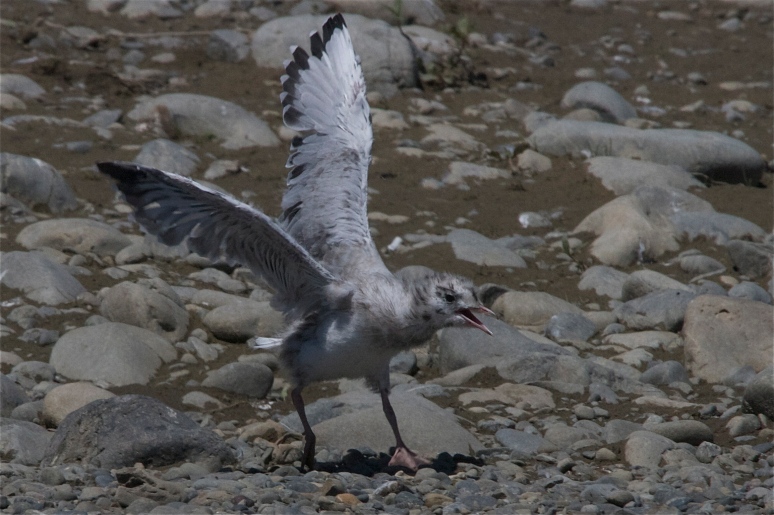
A black-billed gull chick tries its wings, protected in the Ashley colony by growing community surveillance
Having worked in conservation education for many years my experience is that when people are given the chance to be good, they frequently are good, but they need to understand why. And, when they do, they often become passionate advocates for the precious species in their midst.
But it should not, of course, have to take the plight of a rare and threatened species for us to take action against the callous, or at least indifferent, cruelty meted out to the animals we share our environment with. The red-billed and black-backed gulls are abundant, but this does not make the cruel killing of them any less deserving of condemnation.
If we are to resolve this issue, good people must be given the knowledge, and the chance, to be good and, more important, enabled to do good. For it is a truism that (and I quote): “the only thing necessary for the triumph of evil, is for good men to do nothing.”
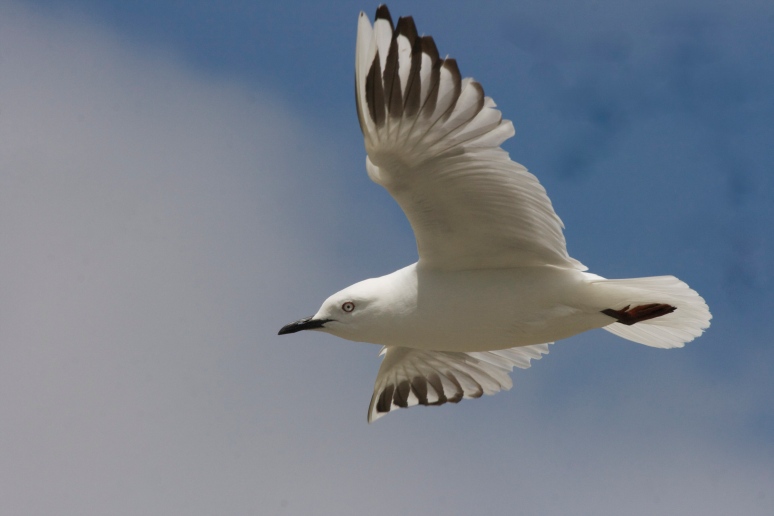
“rally each heart at the sight of you silver wings” (adult black-billed gull in flight – Larus bulleri)
Look at the way I glide
Caught on the wind’s lazy tide
Sweetly how it sings
Rally each heart at the sight of your silver wings
Jonathan Livingston Seagull, lyrics by Neil Diamond.
Wild, wild and blinding
“Suppose, sweet eyes, you went into a distant country
Where these young islands are nothing but a word;
Suppose you never came back again by Terawhiti:
Would you remember and be faithful to your bird?
And when they boasted there of thrushes, larks and linnets,
Would you hold up a stubborn little hand,
And say: “Not so! I know a sweeter singer
Than any bird that cries across your land!”
Would you, remembering, tell them of the Tui?
Wild, wild and blinding in its wildest note.
They – they never heard him, swinging on a flax–flower,
Mad with the honey and the noon in his throat.”
(an extract from the poem by Eileen Duggan)
The special occasion bird
On my first visit to our capital city, when I was still a naive small-town country boy, I went to the Wellington Zoo where I had my first up close and intimate encounter with a tui.
It was in an old fashioned aviary with thick mesh that made it hard to see the bird inside. But as I pressed to the wire, my fingers gripped through the gaps either side of my face, the tui came to me, chorused a glorious song, gave a distinct ‘hello’ – a far more accurate rendition of the human voice than any parrot – and then proceeded to lick the salty sweat off my fingers. The touch of its feathered tongue was infinitely soft, almost a nothing, but I still thrill to the sensation to this day!

like the bird in the Wellington zoo, this tui was old, its feathers bedraggled. But still it’s voice was sound.
As I have commented in a previous blog, my Canterbury childhood was populated with the glorious voice and modest moss green of the korimako (the New Zealand bellbird), which is the second largest of our native honeyeaters. The largest os these nectar eating birds is the tui and, although it is abundant throughout most of the country, they are rare in the dry bush patches dotting the Canterbury plains where the bellbird dominates.
I never saw a tui in the patch of native bush behind our house but, very occasionally, would see one at nearby Peel Forest on the edge of the plains where the extent of forest was greater and the climate wetter. But for reliable sightings of this ‘parson bird’ I had to travel a much greater distance – south to Otago, west to the Wild West Coast or north to Marlborough.

The English settlers called this the parson bird, a seemingly black coat with a clerical collar at its throat. But in the light the tui is a glorious kaleidoscope of colour.
So, for me, the tui was a very special bird indeed. I came to associate it with the adventure of a holiday. The tui was one of the birds I looked forward to seeing when my parents took me on wonderful motoring holidays , travelling throughout the South Island. Staying with my beloved Aunty Joan in Nelson, who shared and encouraged my passion for wildlife, was often on the agenda.Visits to her were always notable for the tui that came to her garden ,where I would sit in her ancient rocking chair on the small deck and watch them squabble over the blossoms or the honey jars she strung in the trees to draw them in and ease their winter. For this reason I’ve always been very fond of tui; my special occasion bird that came to symbolise long hours of family time in places new and thrilling.
As an adult, I came into tui heaven when I moved away from South Canterbury; first to Southland where they spangled the blossom trees in the botanic gardens, and then Hokitika on the West Coast. The Coast, in particular, was a haven for tui. There, in the small garden outside my office window, I’d see them singeing their foreheads with the fire of harakeke pollen.
Auckland and Wellington, too, were remarkable for the tui that came into suburbia and sang from trees on the edge of motorways as if the cars were not there and the whole domain a forest for them to glory in.
In the capital I was woken to tui song every morning, no matter the time of year. A tui living in the Mt Victoria forest at our back door favoured a neighbour’s tall Norfolk pine as his singing post and greeted the dawn from the top of it every morning. His song was always cheerful, but when the harakeke was in bloom and the pohutukawa blossoms were bursting into summer like scarlet fireworks, then his song took on a volume, intensity and complexity that is unrivalled in the avian world.
Sometimes his song would reach such intensity his notes would scale beyond human hearing and you would see his bill gaping, throat pulsating and breast puffing, but could only imagine that other tui (and local dogs) were being enthralled by his virtuosity.
His human-audible repertoire included glorious melody, single chimes of great purity, spiraling downward trills and ascending scales, organ-like notes filled with vibrato; and an almost paradoxical collection of grunts, wheezes, gurgles, coughs, chunks, chonks, and the harshest of screeches. Occasionally city noises would also fill out his musical arrangements, especially a tone-perfect imitation of a car alarm and a neighbour’s doorbell.

A youngster, with a dull coat and yet to achieve the splendour of the adult’s filigree cape and throat poi
Back now in the Canterbury dry lands the tui is again a bird to visit elsewhere, but not so far now. Reintroductions of this bird to the Banks Peninsula Hills, one of its few Canterbury strongholds prior to agricultural clearance, mean I need only visit the close hills to the east to hear the distinctive whirr of their wings and their choral proclamation of ownership over the local stands of kowhai, blue gum blossom and fiery rata trees.
Websites
http://www.nzbirdsonline.org.nz/species/tui
http://en.wikipedia.org/wiki/Tui_(bird)
http://www.doc.govt.nz/conservation/native-animals/birds/land-birds/tui/
Glorious Victoria
Glorious Victoria
It might seem strange, given my preference for photographing birds native to New Zealand, that since my return to Christchurch one of my favourite photography spots has become Victoria Park, a highly modified environment on the northwestern slopes of Banks Peninsula where the steep volcanic hills join the edges of the Canterbury Plains.
This is a large park comprising a number of different environments, all of which have been created or heavily modified by humans. In places it has patches of second growth native bush, especially in the steep valleys, which is slowly maturing and tall canopy trees are starting to peak above the smaller trees and shrubs, aided by supplementary native planting.
In other parts of the park, early European settlers have planted acres of introduced trees typical of northern hemisphere woodland. Interestingly, native trees, shrubs and ferns are coming up through these mature oaks, elms, sycamores, hawthorns, ashes, willows, poplars and conifers (to name a few), creating a post colonial landscape unique to New Zealand.
In other areas large numbers of eucalypt from Australia have been planted, the resinous gum leaves inhibiting the undergrowth; this is an open, light and accessible forest with only a few hardy shrubs that seem able to cope with the natural plant inhibitors in the fallen gum leaves.
The once heavily forested tops are now bare tussock; the original bush – tall with rimu, matai and totara – long milled and cleared for farming, except for a few, very precious, bush islands. And, finally, there are areas of groomed lawn with the occasional shade tree where children frolic, finches glean seeds and blackbird and thrush probe for worms.
I can always count on this park to present interesting native and introduced plants, an ever-changing parade of birds, a good walk along its often-steep trails, and spectacular views. In a relatively short time one can wander from a dense native bush gully, lush and green; through open meadows dotted with introduced specimen trees; then though thick European woodland tangled with blackberry and scented with flowering currant; up through crackling dry eucalypt forest and, finally, onto the open tops with sweeping tussocklands and bare volcanic crags.
Perhaps because of this variety of ecosystems there is a great variety of birds, native and introduced. Recent planting of native species has assisted the re-establishment of native bird life, notably the kereru (NZ pigeon – Hemiphaga novaeseelandiae), riroriro (grey warbler – Gerygone igata), Piwakawaka (fantail – Rhipidura fulginosa), korimako (bellbird – Anthornis melanuris), and tauhou (silvereye – Zosterops lateralis). The open tops host the native kahu (harrier hawk – Circus approximans); putangitangi (paradise shelduck – Tadorna variegata) and torea (South Island Pied Oystercatcher – Haematopus ostralegus finschi) nest in the open fields; kotare (sacred kingfisher Todiramphus sanctus) use the clay banks and tree hollows for nest sites and haunt nearby ponds and streams ,or hawk cicadas from among the trees. The park is also abundantly populated with common European introductions such as sparrow, chaffinch, goldfinch and greenfinch, blackbird and thrush, yellowhammer and cirl bunting, redpoll and skylark and california quail.
Tree planting is a traditional activity in Victoria Park, with many groups and individuals participating in planting events. Some non-local natives have been planted in eastern bush such as kauri and the rare Pittosporum dallii. On the warmer western slopes exotic specimens such as proteas, banksias, grevilleas and leucodendrons can be found. Also noteworthy, the existence of silver tussock so close to a city centre is said to be unique in the Southern Hemisphere and possibly the world.
In one of my spring wanderings the understorey of the exotic/native mix forest was rich with the spicy scent of flowering currant. The scent is from the new leaves, not the flowers. In autumn the tauhou gorge themselves on the berries.
Spring is also when the glorious native flowering tree kowhai (Sophora microphylla) bursts into flower and the korimako and tauhou descend on them in good numbers to feast on the nectar. Interestingly sparrows do too, but they cheat, biting into the rear of the flower to access the nectaries directly because, unlike the native birds, they do not have a special tongue to collect the nectar ‘legitimally’. The other herald of spring are the native clematis, first the puawananga and then the strongly perfumed clematis foetida. This is an unfortunate name as the smell of this small greenish yellow clematis is pleasant, reminiscent of nutmeg and daphne. If you get a lot of it at once, it can be a bit overpowering, but hardly foetid!
In high summer the grasses burn brown and the inflammable scent of eucalyptus oil drifts threateningly through the valleys – an incense prayer to the fire gods for a lightening strike or perhaps a wind to drop a crackling wire from the hilltop radio towers – for eucalypts were born to burn and send their seeds into the ashes of the fire.
Autumn produces an abundance of fruit, nuts and berries from the mixture of trees, and the native birds will just as happily take wild cherry plum as the fruit of the native karamu. By this time, too, piwakawaka are in abundance. These little birds are super breeders, producing around five clutches from spring to the end of summer. They need to, the winter takes a heavy toll on these flickering denizens of the forest edge and cheerful companions of the walking human.
The hills of Banks Peninsula are high enough above the Canterbury Plains to attract snow in winter.
The park, then, is a popular playground, especially for parents with tobogganing youngsters. The fantails are seriously depleted at this time of year and can sometimes be seen huddled together in roost trees sharing their meagre warmth. The hardy tauhou has a better solution, it migrates to the suburban gardens where exotic berry plants and fruits (and friendly bird tables) sustain them through the cold.
But none of the seasons last and, at the time of writing, spring is well underway yet again. The tauhou have left our garden and returned to the hills and forests. Kowhai has burst forth in its short-lived blaze of glory and will soon fall to carpet the forest floor with a fading yellow; suddenly fierce oystercatchers will launch themselves at the unwary wanderer who has come too close to their shallow nest in the short grass fields; and the silver tussock will shine as bright as a summer sky.
-
Recent Posts
Flickr Photos
Categories
Archives
- May 2016
- September 2015
- April 2015
- August 2014
- July 2014
- May 2014
- March 2014
- December 2013
- October 2013
- August 2013
- June 2013
- May 2013
- March 2013
- February 2013
- January 2013
- October 2012
- September 2012
- August 2012
- July 2012
- June 2012
- May 2012
- April 2012
- March 2012
- February 2012
- January 2012
- December 2011
Meta


